Wilhelmsen Ahrenkiel Ship Management
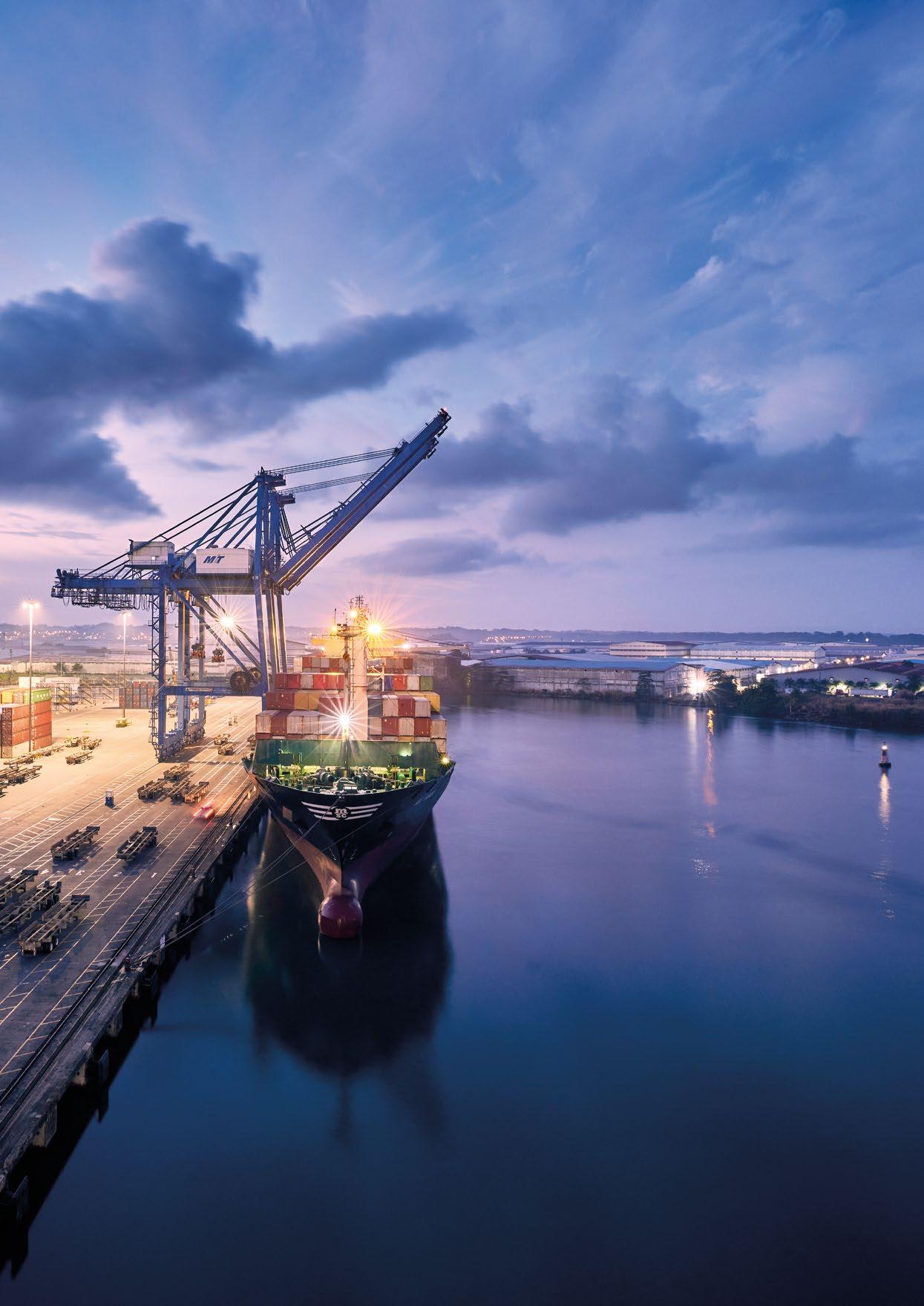
STORIES AND SHORT NOTES ON SHORE AND ON BOARD
Experienced and written by our Wilhelmsen Ahrenkiel Team
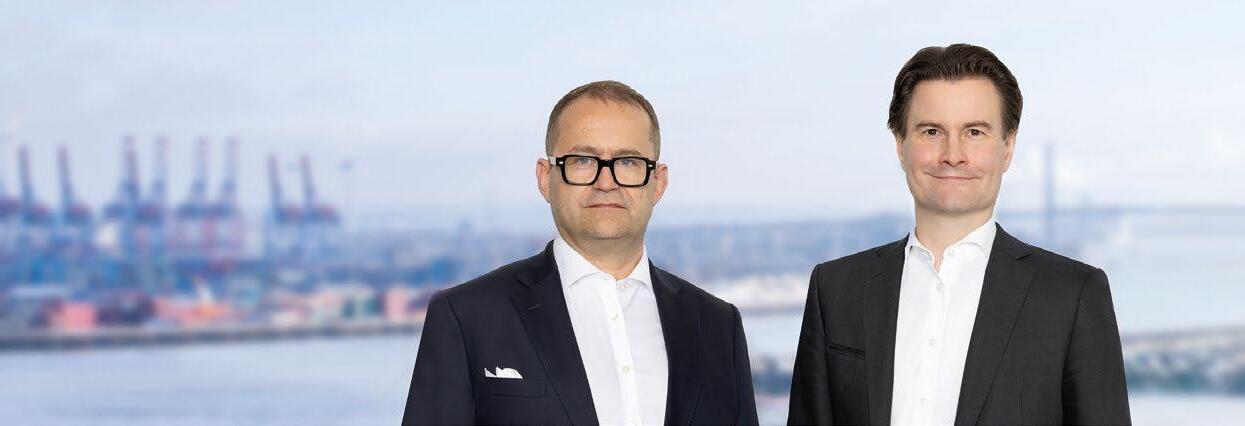


Experienced and written by our Wilhelmsen Ahrenkiel Team

A lot has happened since our last issue in 2023: To strengthen our position in the market, Wilhelmsen Ahrenkiel Ship Management acquired the technical ship manager Zeaborn Ship Management in December 2023. We are grateful to our shareholders Wilhelmsen Ship Management and MPC Capital AG who have supported us in this transaction in all aspects.
With 64 ships in technical management and 83 ships in crew management, this not only doubles our fleet, but it also diversifies it: In future, we will not only manage container ships, but also bulk carriers, multi-purpose vessels and, via our sister company Barber Ship Management, tankers. This will allow us to expand our customer base, operate more efficiently and not be dependent on the market situation of one type of ship.
We are currently working together to integrate Zeaborn Ship Management into Wilhelmsen Ahrenkiel Ship Management. We have formed six workstreams involving employees from Zeaborn Ship Management, Wilhelmsen Ahrenkiel Ship Ma-
nagement and Wilhelmsen Ship Management. We are currently planning to switch systems at the end of the year and relocate together to our new offices in Palmaille. We are very much looking forward to welcoming our new colleagues soon!
This editorial, which we are writing together for the first time, is an obvious sign of change. Michael Brandhoff joined the management team as Managing Director in April 2024. We are delighted to have his knowledge and experience onboard! Furthermore, we are happy to advise that Carlé Olivier has taken over the role of Marius Dietrichson as Financial Director. We congratulate her and are very much looking forward to our future collaboration.
The many retrofit projects that we are carrying out in 2024, particularly at Chinese and Turkish shipyards, show just how much the need for decarbonization is now also dominating the shipping business. This means a lot of extra work for our employees and crews, but also allows us to participate in this interesting development.
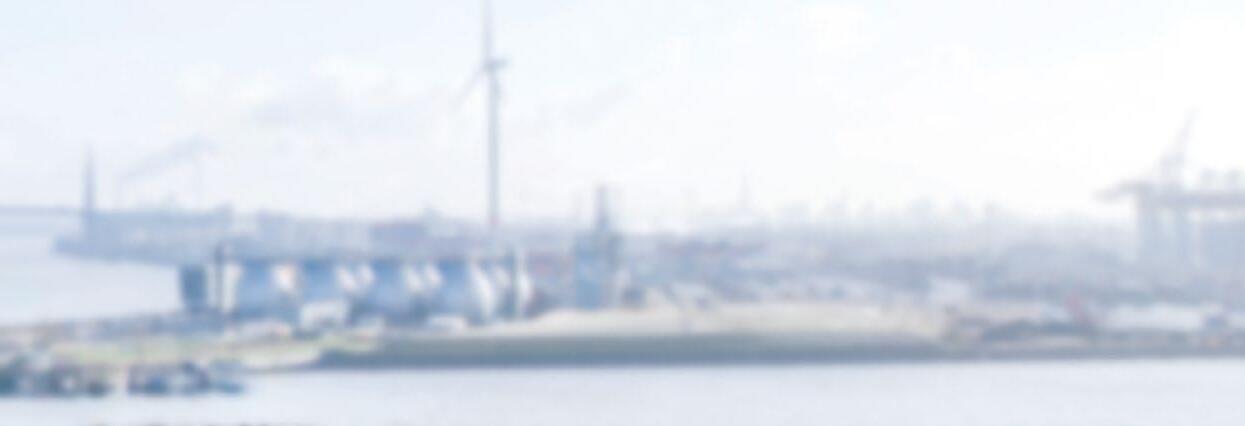
The efficient container newbuilds that we are currently closely supporting in South Korea and China are also contributing to decarbonization. We are delighted to be able to provide technical support for newbuilds again after a long time with the ships Danube, Ganges, Mississippi, Mackenzi, and Colorado. At the end of the year, two more vessels (Dual-Fuel Methanol engine) will be delivered, which are intended for a Norwegian-German-Dutch trade.
During the last year we had intensive, open and friendly discussions with our seafarers at the crew seminars in Bulgaria and the Philippines. We are very grateful for their tireless commitment, loyalty and faithfulness! Rest assured: the next conferences are already in the planning stages.
We understand the challenges of this time, especially against the backdrop of the ongoing wars. We have been offering the services of Mental Health Support Solutions (MHSS) to all seafarers for some time now. The excellent presentations given by the MHSS specialists at our crew
seminars have prompted us to offer these in our offices in Rhoon and Hamburg with great success.
All the articles in this Telegraph were also written by our employees and give a good picture of our activities. We would like to thank everyone who has contributed, especially Mia-Kaarina Feistner. We hope you enjoy reading this issue!
Yours sincerely, Wilhelmsen Ahrenkiel Ship Management
Michael Brandhoff Managing Director
Dr. Michael Silies Managing Director
CYBER SECURITY IS GAINING INCREASING IMPORTANCE IN TODAY’S ENVIRONMENT NOT ONLY IN THE OFFICE, BUT ALSO ON BOARD THE VESSEL. IN THAT CONTEXT, SECURITY DEPENDS ON 3 PILLARS: PEOPLE, PROCESS AND TECHNOLOGY.
By Sophie Simov
Newbuild vessels, where the building contract is signed on or after 1st July 2024 and classed by DNV, are subject to mandatory class notation Cyber Secure. Based on relevant IMO regulation, this notation delivers a structural approach to design and implement relevant barriers on board the vessel to identify, protect, detect, respond to and recover
from cyber security incidents. Ahead of requirement, 5 vessels of the Wilhelmsen Ahrenkiel Fleet were selected in 2023 to operate under the umbrella of this class notation. It defines several levels, for the 5 vessel SP(0) was selected which constitutes the entry level. Great initiative, but quite some endeavour with the need to overcome several obstacles.
The process started with an enlarged desktop study, reviewing in detail 11 essential functions e.g. Propulsion, Navigation and Communication and the corresponding systems down to the component level. Led by the below-mentioned 3 key questions, the aim was to identify the relevant system that needs to be included in the scope for the class notation.
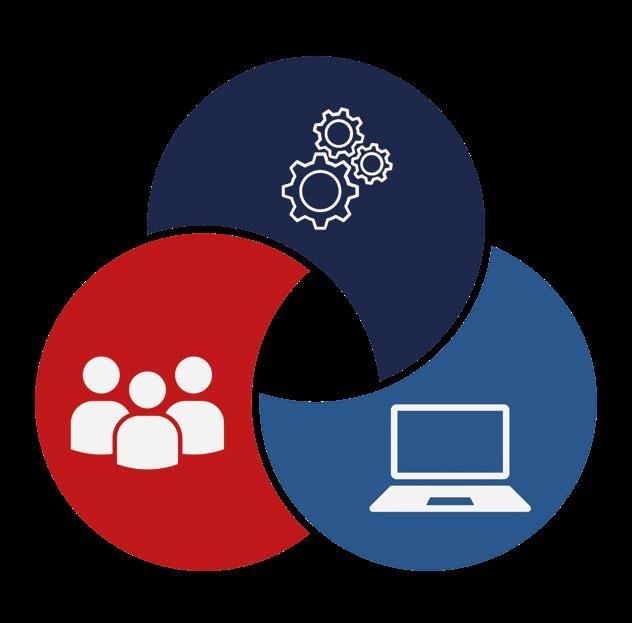

• Is the system equipped with IP-based network connections to other systems (including potentially remote access solutions)?
• Is the system placed outside restricted areas?
• Is the system equipped with software or configuration that cannot be updated, or can only be changed by the manufacturer using special tools and/or proprietary interfaces?
A system determined to be in scope must be proven through documentation to meet 18 cybersecurity requirements, e.g. in areas of user authentication, system integrity or data confidentiality. To achieve this, we relied on close cooperation with various global system manufacturers supporting the project with input and detailed documentation. In some respects, this outlined a challenge, as for us and for some of the manufacturers, Wilhelmsen Ahrenkiel and the request was the trial project to get ready for the future requirements. In essence, all relevant information along with applicable references was summarised in the Cyber Security Design Philosophy and handed to class for approval.
Once the 1st milestone had been achieved, the second phase of the project was initiated – onboard testing. The vessels subject to class notation Cyber Secure were visited by DNV’S penetration tester to proof the correct application according to the documentation and fulfilment of the individual requirements. The testing on board each of the vessels lasted for 3 days, examining the individual systems in detail. Apart from the DNV Class Surveyor, the
process was accompanied by a consultant who supported the overall project as well as manufacturers’ representatives presenting the individual systems.
During daily operation, there is one obvious thing that is different. The vessels are equipped with USB and LAN port blocker in all areas, relevant systems like e.g. the Performance Monitoring system deliver their data directly to the cloud via remote connection. In consequence, the use of USB sticks or other removable devices is aimed to be reduced to the bare minimum. For these vessels, the Master is nominated as the Ship Cyber Security Officer, and further, we rely on the vigilance and alertness of him and the crew as one important part of being Cyber Secure.
I would like to use this opportunity to sincerely thank everyone involved in this project, sailing in tough waters but writing a success story in the end.
Introduction
Ownership of container vessels is split between container lines and non-operating owners. Technical management is done by main carriers and non-operating owners or dedicated ship managers like Wilhelmsen Ahrenkiel Ship Management (WASM).
WASM provides services for container lines and international, institutional investors, always acting as agents for and on behalf of the owners. Managers undertake to use their best endeavours to protect and promote the interests of the owners.
Considering investors’ increasing needs, personnel, tools and processes must be adapted. Part of the job is handled by the authors of this piece, Relationship Manager Marcel Moskalik and Key Account Manager Holger Glandien.
Born in 1992, related neither by blood nor marriage to the world of shipping, I, Marcel, grew up in a small city near Hanover, which is not quite known for being a maritime hotspot. Similar to the fact that there was no salient connection to the sea in the early years of my life, there was also no obvious link to the football club that
I still support to this day. Still, I have chosen Borussia Dortmund.
Close to my high school graduation, I developed a growing fascination for shipping and decided to study Nautical Science in the city of Leer. The maritime tradition that is perceptible in every corner of the city continued to appeal to me all the way through my studies. Consequently, it was my desire to become a navigator and so I did.
I started my career as deck officer on board medium-sized iced classed oil and chemical tankers. The vessels mostly oper-
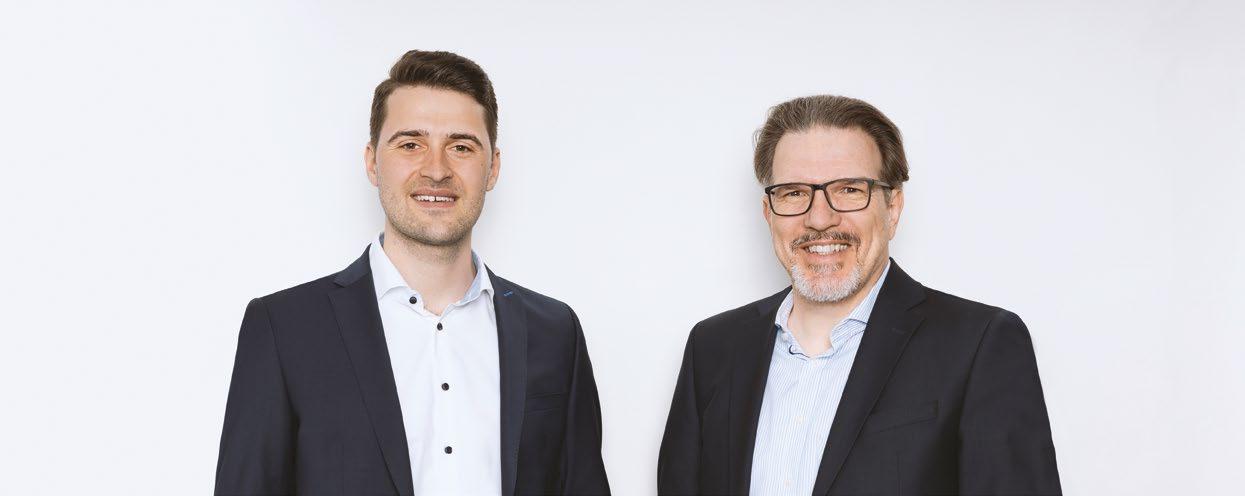
ated in Northern Europe, a challenging trade which is known for customers that demand the highest safety standards, as well as operational quality and reliability. The process-based but practical approach to risk management and a striving for continuous improvement, both fundamental requirements in the industry, formed my understanding of prudent ship management.
With this understanding guiding my way, I became Marine Superintendent in 2018 with a Hamburgbased tanker ship management company. During regular ship visits for the purpose of inspections, audits, pre-vetting or dry-docking supervision, I always enjoyed the interaction and valuable exchange with the crew. The experiences formed on board helped me contribute to the advancement of the company’s management systems.
Being new to Wilhelmsen Ahrenkiel – I just started in November 2023 – I must admit that is a pleasure to work in a team that is comprised of professionals with diverse backgrounds but all of them working towards a common mission of delivering the highestquality services to our customers.
I, Holger, was born in 1964 close to Bremen and raised in the hometown of Werder Bremen, four-time winner of Germany’s Football Championship. The Hanseatic city of Bremen with its port, maritime facilities and commercial heritage influenced my career.
After graduation from high school, I started an apprenticeship with a bank, achieved my degree, did my 15-month basic military service, and worked as a bank clerk. Despite being very much interested in economy and finance, I was not attracted by the idea of spending decades in a bank.
I decided to expand my education by studying business administration. I spent time studying, jobbing, travelling, playing football and earned a degree from the University of Göttingen.
Family and the beautiful city of Bremen pulled me back. I began working in the financial department of a shipyard in Bremen. This involved dealing with pre-delivery finance of newbuildings via banks and European export credit agencies, calculating profitability of new projects from a buyers’ perspective, and modelling different charter rates, OPEX, interest and foreign exchange rates based on shipyards’ asking price.
owning entities with monitoring of technical ship managers and information of private investors.
In summary, it is fair to say that not taking the most obvious choice can lead to the best choice – whether it is the right football club or a career in shipping.
I moved from the shipyard to the Hamburg-based MPC Capital in the first quarter of 1996. There, the focus was on calculating and structuring investments in shipping. My responsibilities ranged from seeking debt financing including interest rate swaps and FX trades to managing ship-
Since 2019, I have been the contact for WASM’s institutional investors. I appreciate digitalisation and new tools like Tableau providing more transparency for WASM and our clients.
Married with 4 children, I spend my free time playing football, watching my football-playing daughters and travelling with my beautiful wife, with or without our children.
Being a young Baby Boomer, I love attending concerts with artists ranging from AC/DC to Adele, Depeche Mode to DIIV, and The The to Taylor Swift. I attended Grauzone Festival in The Hague, Netherlands, in February 2024 and enjoyed Hurricane Festival in Scheeßel, Germany, in June.
Conclusion
Our complementary backgrounds – technical vs. financial – combined with our dedication to team work and customer satisfaction enable us to fulfil WASM’s mission of providing high-quality ship management services in a demanding environment.
HAVING PROPER INSURANCE COVER IN PLACE PLAYS AN IMPORTANT ROLE – IN RESPECT OF PERSONAL MATTERS, AS WELL AS WHEN IT COMES TO OWNING HIGH-VALUE PROPERTY IN A COMMERCIAL CONTEXT.
By Alexander Brandenburg
Considering that over 80% of international trade in goods is transported by sea, one will realize the values involved day-byday and that same is not without risks, both in respect of the goods that are being transported as well as the individual vessel and its equipment itself. Hence, it is vital to have appropriate protection in place to respond to the risks the crew members on board are faced with, the environmental risks involved, the financial exposure of the individual ship owners and all its customers and stakeholders.
By providing technical ship management services, Wilhelmsen Ahrenkiel Ship Management is also affected by this. Foremost, due to the fact that a standard ship management contract provides the ship owners with the option to request the ship
manager to be responsible for the insurance arrangements. Secondly, being a responsible ship manager, Wilhelmsen Ahrenkiel Ship Management is continuously considering prevailing risk factors and safety requirements by reviewing the vessel’s trading pattern and corresponding national and international regulations, maintaining the vessel and its engine in accordance with good seamanship and manufacturer’s recommendations and responding to casualties and emergency situations as they may occur.
Nonetheless, the crew on board, as well as the ship managers and owners ashore, are sometimes faced with unexpected circumstances. Therefore, proper protection against the exposure to claims and huge costs involved by placing those risks with insurance
companies within the international marine insurance sector is crucial. Arranging insurance cover for owners of a vessel includes but is not limited to mandatory liability insurance (also commonly referred to as Protection & Indemnity insurance), Hull & Machinery insurance covering the property itself and damages thereto, and War Risk insurance. It may also include, among others, insurance cover for the loss of charter income (also called Loss of Hire insurance), legal expense cover (often referred to as FD&D insurance) or diversion expenses in cases where a vessel has to deviate from its planned route due to an emergency situation on board or, for instance, due to a searchand-rescue operation or similar.
To be in a position to offer these services in an appropriate way
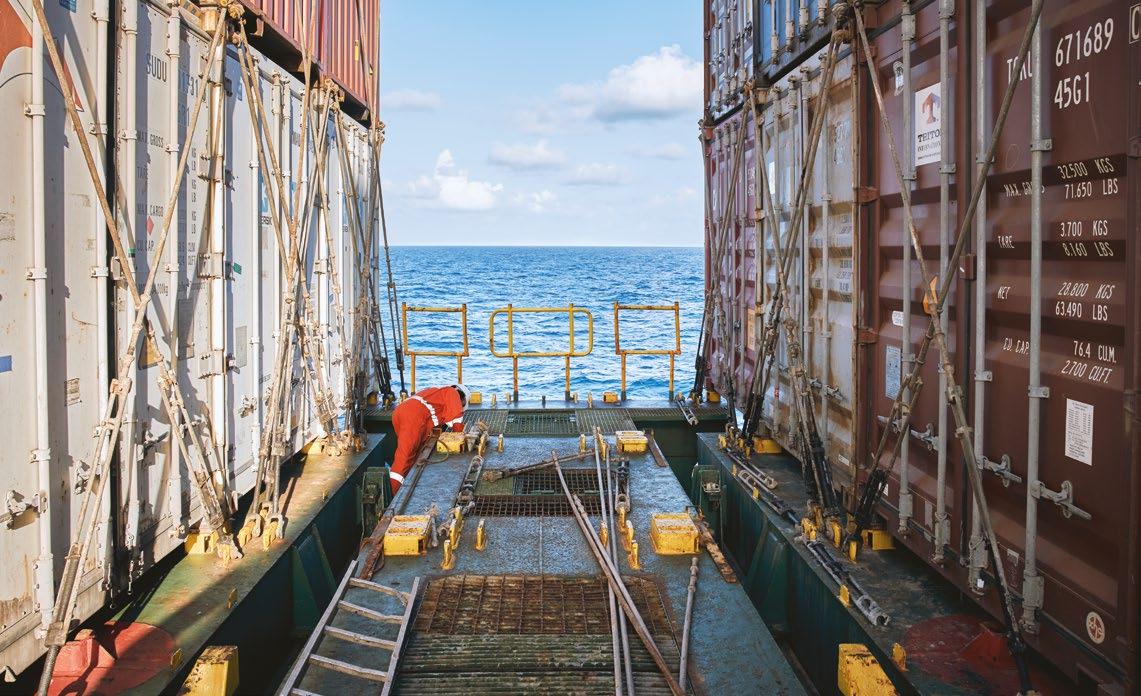
and in line with its vision and mission statement, Wilhelmsen Ahrenkiel Ship Management has established a dedicated Insurance Department. The insurance department is responsible for all kinds of insurance-related matters, starting from placing and maintaining those insurance policies as per owners’ requirements (in close collaboration with Marine Insurance Brokers), but also handling all kind of insurance cases up to the successful finalization and claim reimbursement from insurers to the owners.
In its role, the insurance department is acting as a link between the different departments of Wilhelmsen Ahrenkiel Ship Management and the involved insurers, allowing the technical departments to focus on the rectification of a defect and dealing with the prevailing sit-
uation at the best possible terms. Wilhelmsen Ahrenkiel Ship Management is of the view that maintaining an in-house insurance department adds high value to the overall success of the offered ship management services, not only in terms of short communication paths in-house and towards the insurers, but also by being members of the manager’s emergency response team, considering the risks involved as well as providing loss prevention and mitigating advice on a day-to-day basis.
Having appropriate and reputable insurance cover in place for a seagoing vessel is certainly not just ticking a box but has a great impact on the overall success of a ship owner in operating its property in a safe, efficient and sustainable manner and maintaining their good reputation.
Through its dedicated insurance team, Wilhelmsen Ahrenkiel Ship Management is delighted to support the arrangements of proper insurance cover and is happy to assist with whatever challenges may arise – always with the aim of contributing to a safe and sustainable management of the property of their clients.
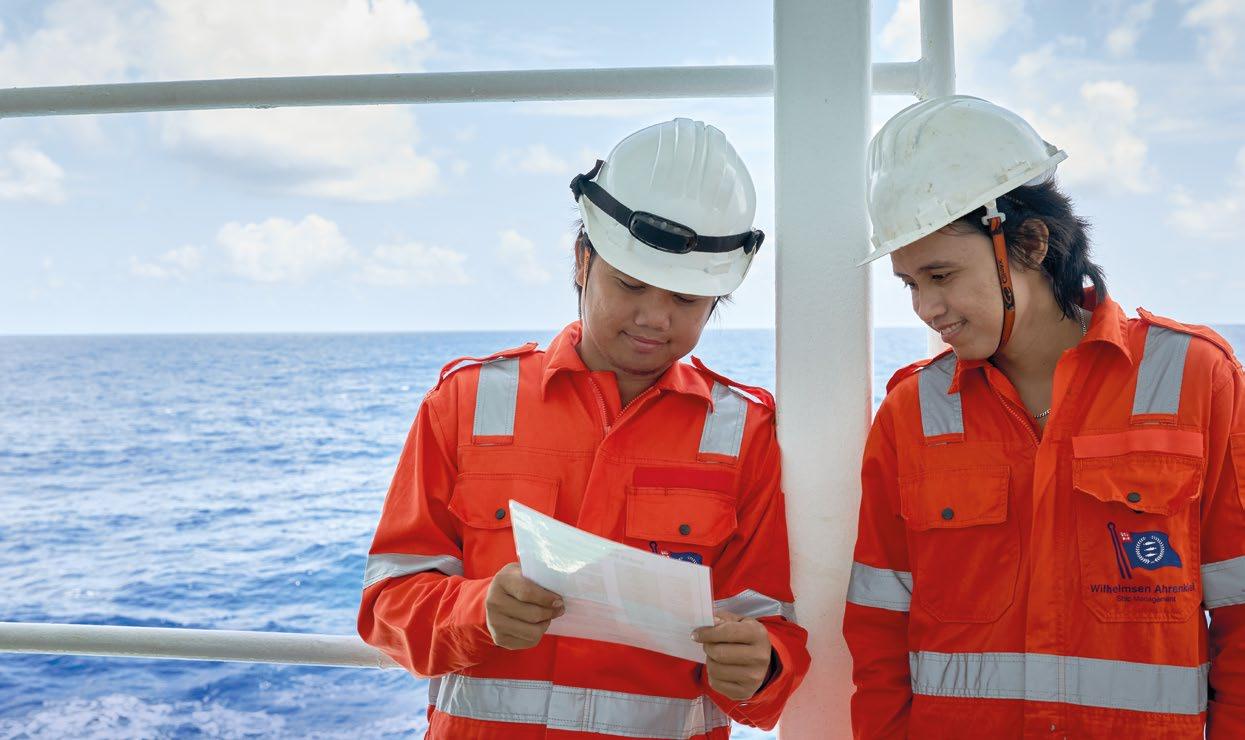
MARINE INCIDENTS HAPPEN IN TODAY’S DYNAMIC ENVIRONMENT AND THESE INCIDENTS HAVE THE POTENTIAL TO EVOLVE INTO MAJOR CASUALTIES IN AN UNCONTROLLED MANNER.
By Lena Marie Heick
A rather recent example is the collapse of the Francis Scott Key bridge in Baltimore, Maryland, US, which does not only result in a major financial damage for the shipowners and port operators i.e. all other stakeholders, but bears in excess of that several other consequential risks such as loss of life, reputational damage and damage to the environment.
Unfortunately, such incidents are almost unavoidable, since several factors contribute to the causation of such marine casualties, which no party is completely protected against. If, however, these incidents occur, it is crucial as a shipowner to have certain proper emergency response procedures in place that support the mitigation of losses at a very early stage. In the world of technical ship management, marine risk assessment and Loss Prevention play a deci-
sive part in our business construct and are profoundly incorporated in all sorts of fields of our daily operations, thus rendering comprehensive services to shipowners.
A key component of loss prevention in technical ship management is carrying out comprehensive risk analyses that help to identify potential sources of risk and enable managers to develop appropriate prevention strategies.
This not only includes regular inspections and maintenance of the ships as well as the implementation of strict safety protocols, but also continuously monitoring potential areas of particular risks to optimize our existing processes and procedures according to the newest risk developments in respect of navigational errors, geopolitical uncertainties and international regulatory standards.
WASM therefore cooperates with a wide variety of business providers in the insurance sector that have enrolled Loss Prevention programs, based on real case studies and collective data, that are made public to shipowners and members to enhance and contribute to safety in the maritime sector globally.
The International Group of P&I Clubs providing marine liability cover for 90% of the world´s ocean-going tonnage, for instance, collect and evaluate data supported by a wide global network, consisting of several shipowners, managers, charterers, correspondents, and law firms. This mutually added value, which has been gained throughout recent years, has proven to be of significant importance in handling major marine casualties and loss mitigation. Therefore, close collaboration and the selection of suitable business partners that support shipowners in a crisis play a crucial role.
Regular inspection and maintenance of the ships is crucial to ensure that international safety standards are met and that potential defects are promptly identified and rectified to avoid severe machinery damages. This includes both planned maintenance work and precautionary technical measurements that may avoid unforeseen costly repairs.
Advances in technology have revolutionized technical ship management and opened new possibilities for loss prevention. For example, advanced monitoring systems are used to observe the condition of vessels in real time and detect potential problems at an early stage. Automated systems such as Artificial Intelligence may also help in reducing human error by optimizing certain procedures. Although artificial intelligence features are still at a very early stage of development, WASM is adapting to the latest market standards and continuously investigates in potential on-board solutions to profit from such advanced tools.
The crew plays a significant role in loss prevention since our onboard staff has the necessary knowledge and skills to perform safety-related tasks effectively. Training programs that focus on safety procedures, emergency response and the use of modern technology are essential to minimize the risk of accidents and damage. Therefore, WASM frequently invests in the enrolment of training programs that enhance the awareness of the staff ashore and offshore proactively on how to best prevent incidents.
Loss prevention in technical ship management is a complex and continuous process that requires a holistic approach. Through a combination of risk analysis, training, technological solutions and emergency management, technical ship managers can ensure the safety of vessels and crews while protecting the financial stability of ship-owning companies.
As a well-reputed technical ship manager, our aim is to continuously grow our expertise to provide our customers with excellent and up-to-date standards.
THE SUMMER OF 2023, WILHELMSEN AHRENKIEL SHIP MANAGEMENT WAS ENTRUSTED WITH THE TECHNICAL MANAGEMENT OF FIVE ECO FEEDERS WITH A CAPACITY FROM 1.700 TEU TO 2.200 TEU BY MPC CONTAINER SHIPS ASA.
By Kiril Kirilov
This management contract provided Wilhelmsen Ahrenkiel Ship Management with a stronger position in its technical management services in the feeder segment. With the acquisition of these vessels, MPC Container Ships continues the fleet modernisation in accordance with the latest environmental requirements and decarbonization trend in the shipping sector.
The takeover processes were well prepared and synchronized within the shore organization of Wilhelmsen Ahrenkiel Ship Management and takeover groups were assigned. New Owners’ representatives were sent on board in advance to familiarize themselves with the vessel’s conditions, the present routes and Charterers’ demands. It was of utmost importance in the planning phase that the takeover activities should not impact Charterers’ schedules.
In accordance with our established internal procedures, after analysis of all information available prior to the takeover about the technical rating and condition of the new vessels, initial
and operational budgets were proposed and agreed with the new Owners. The trading area of the vessels was considered as well, since all of the new ships were operating in different parts of the world – from Australia to Central and South America.
The vessels were surveyed, audited and renamed. The Wilhelmsen Ahrenkiel Ship Management safety management system was established. Additionally, a new plan maintenance system was installed and implemented. All vessels are now sailing under the Liberian Flag.
The ECO notations assigned by class, clearly indicating their improved technical performance and their ability to operate energy-efficiently in correspondence to the latest carbon emission reduction requirements, are of great importance. All the latest technologies implemented on board are influencing the ship’s fuel efficiency from its design phase.
Four of the acquired vessels have an approved lashing program which enables flexibility to select weather- and voyage-
dependent factors for selected specific voyages or routes, thus providing an advantage to Charterers for transporting a higher volume of cargo compared to other vessels of the same size.
We would like to use this opportunity to demonstrate the possibility of delivering to our clients and shipowners a reliable, compliant, cost-effective, high standard of technical management of their assets.
All aforementioned acquisitions went effortlessly due to the dedication, commitment and professionalism of the office staff, the assigned takeover groups, and the new crew members.
We warmly welcome AS Anne, AS Stine, AS Silje, AS Sabine and AS Simone into our management and wish them and the crew always fair winds, following seas and blue skies!
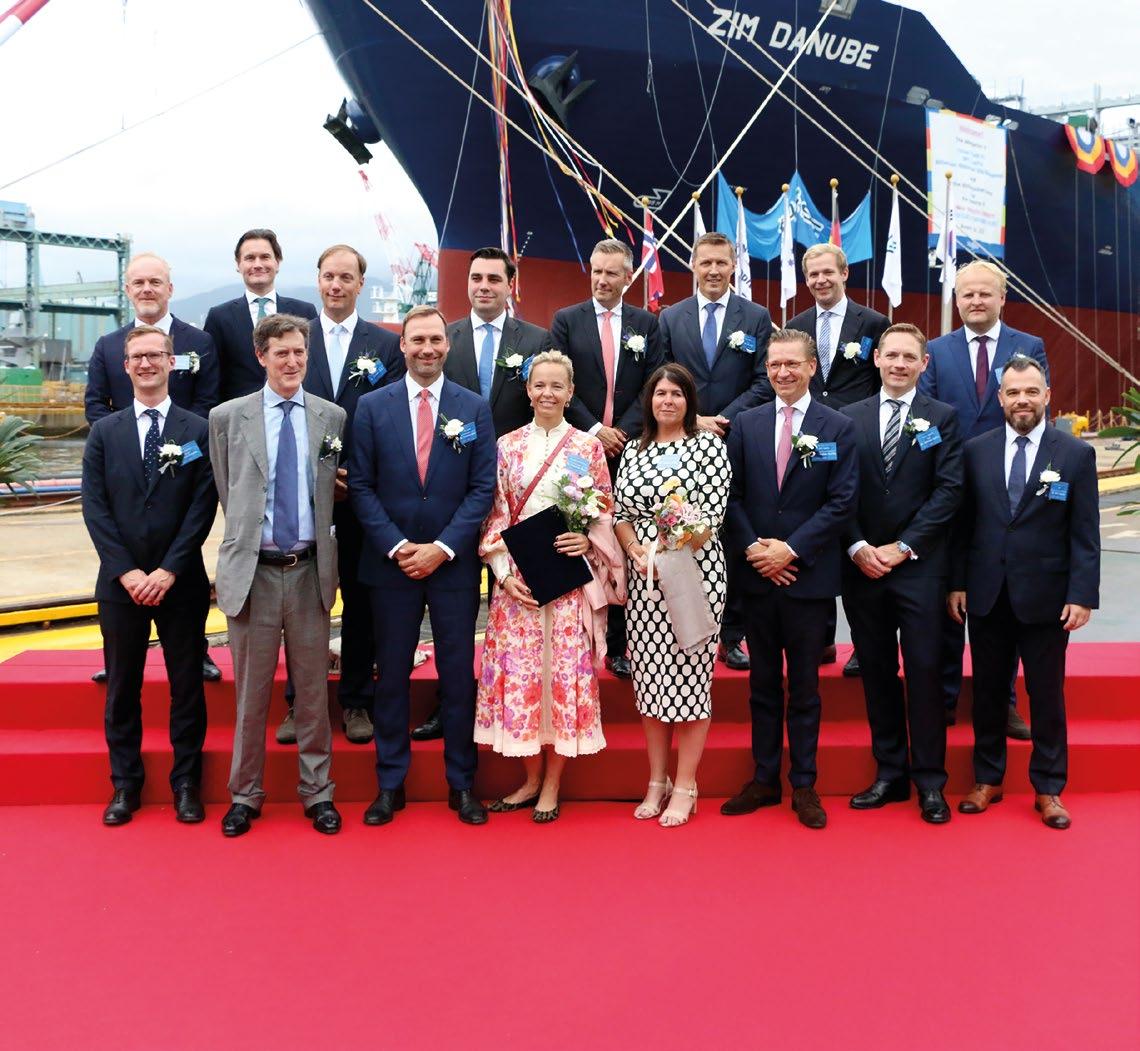
IN 2021, MPC CAPITAL AG PLACED ORDERS FOR THE CONSTRUCTION OF 4+2 5,500 TEU CONTAINER VESSELS WITH HJ SHIPBUILDING & CONSTRUCTION IN CONNECTION WITH A SEVEN-YEAR TIME CHARTER WITH ZIM INTEGRATED SHIPPING SERVICES.
By Hanneke de Vriend
Wilhelmsen Ahrenkiel Ship Management was nominated as the technical manager for five of the six vessels. Together with the Joint Venture partner Wilhelmsen Ship Management, the site team took charge of the supervision of the construction in Busan, Korea.
On August 30th, 2023, the naming ceremony of the first two vessels took place in Busan. Delegations from the cooperating companies took part
in this celebration. The Godmother for MV ZIM Ganges was Frederice Baack, the wife of Mr Constantin Baack, MPC Capital CEO; and Natasha Griffin, ZIM UK country manager, was the Godmother for MV ZIM Danube.
MV ZIM Yangtze and MV ZIM
Mississippi had their naming ceremony in February and the last two vessels Mackenzie and Colorado had their naming ceremony in May 2024.
AS I SET FOOT ON THE BUSTLING GROUNDS OF THE HJ SHIPBUILDING AND CONSTRUCTION (HJSC) SHIPYARD IN PUSAN, SOUTH KOREA, THE SIGHT OF THE MAJESTIC MV ZIM DANUBE STANDING TALL IN ALL HER GLORY WAS A MOMENT OF PROFOUND PRIDE AND AWE. IT MARKED THE CULMINATION OF A REMARKABLE JOURNEY, NOT JUST FOR THE VESSEL BUT FOR ME AS WELL.
By Capt. Angel Vasilev
The journey of MV ZIM DANUBE is not just a story of constructing a ship; it’s a tale of collaboration, trust, and the shared vision between the HJSC shipyard (former name: Hanjin) and the ship management company, Wilhelmsen Ahrenkiel Ship Management GmbH & Co. KG (WASM). The building of the vessel from the keel-laying until the delivery to the owners MPC Containerships ASA & Ocean Yield ASA was under the supervision of the Wilhelmsen Ship Management (WSM) site team.
My maritime education began in 1996 at the Maritime High School “Nikolai Chudtoverets,” laying the foundation for a career built on the high seas. This path led me to the Naval Academy “Nikola Vaptsarov,” and eventually, in 2005, to Wilhelmsen Ahrenkiel Ship Management GmbH & Co KG (former name: Ahrenkiel Shipmanagement GmbH & Co. KG). Nineteen years with the company shaped me, not just as a seafarer but as a leader,
a collaborator and a visionary. The journey with MV ZIM DANUBE started in May 2023, when I was informed of my appointment as her first captain. It was an honour and a responsibility that I accepted with a mixture of excitement and solemnity. The first crucial step was the formation of a strong leadership trio: the vessel manager, the captain and the chief engineer. The announcement that Mr Plamen Petrov would be the vessel manager was the first piece of good news, setting a positive tone for what was to come.
Preparation for this role was intense and involved. Weeks before departing for Pusan, I engaged in numerous online meetings with various WASM departments. Our focus was on implementing the company’s safety management system aboard the vessel and preparing for future safety and security inspections and audits. The crew, handpicked for their professionalism, was tasked with
upholding the high standards of the Safety Management System from the outset. Their role was pivotal in ensuring the seamless operation and safety of the vessel. My first day at the HJSC shipyard on August 4, 2023 was a moment etched in memory. The difference between this shipyard and others was stark:
It was a place where new life began, much like a maternity ward, in contrast to the hospital wards of ship repair yards. The sight of MV ZIM DANUBE and her sister ships, each at different stages of construction, was a testament to the scale and expertise of HJSC.
Daily meetings, trainings and commissioning during the partnership between HJSC, WASM and WSM ensured that every team member was fully aware of the ship’s equipment. This cooperative effort extended to the sea trials, which were an intensive phase of testing and fine-tuning. Scheduled to start on August 10, 2023, they were briefly postponed due to a passing typhoon. When we finally embarked the vessel for sea trials on August 11, it was with a sense of collective purpose and anticipation. Onboard were about 130 individuals, including the manufacturer’s representatives for every piece of equipment. Each system and each mechanism, especially those that could not be tested while in the shipyard, like the main engine, were put through their paces.
The vessel sea trials were not just a test for the MV ZIM DANUBE but a demonstration of the seamless coordination between the crew,
the shipyard, vessel manager and the equipment manufacturers. The successful completion of sea trials on August 18 was a moment of triumph, a testament to the vessel’s readiness and the collective effort of all involved. The pinnacle of this journey was the naming ceremony on August 30, 2023. A tradition believed to bring good fortune, the ceremony was imbued with symbolism and celebration. The vessel, adorned with flags and ribbons, was a sight to behold. The fireworks that followed the champagne bottle shattering against her bow were not just a spectacle; they also served as a ritual signifying the ship’s readiness to navigate the seas. The handing over of the baptismal certificate was not just a formality but a moment of symbolic significance, marking the transition from construction to active service.
Departing from the shipyard on September 6, 2023, MV ZIM DANUBE wasn’t just embarking on her
maiden voyage; she was carrying the hopes and aspirations of all who had contributed to her creation. The seamless collaboration between HJSC, WASM and WSM made it possible for this journey to take place, from the drawing board to the open seas. It highlighted the importance of teamwork, trust and a shared vision in achieving remarkable feats.
As I reflect on this journey, I realize that MV ZIM DANUBE is more than just a vessel. She represents the pinnacle of maritime engineering, the spirit of collaboration, and the relentless pursuit of excellence. This ship, her crew and all those who played a part in her creation stand as a testament to what can be achieved when individuals come together for a common goal. The story of MV ZIM DANUBE and her birth at HJSC under WSM supervision and further care from WASM will always be a shining example of what it means when a star is born in the world of maritime adventures.
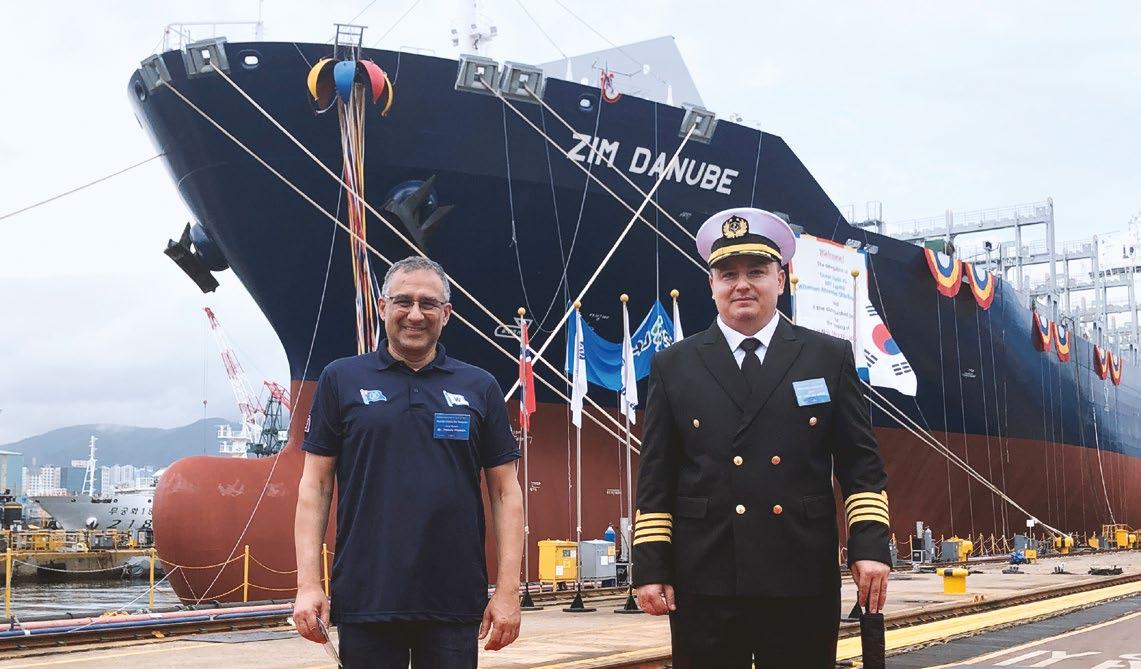
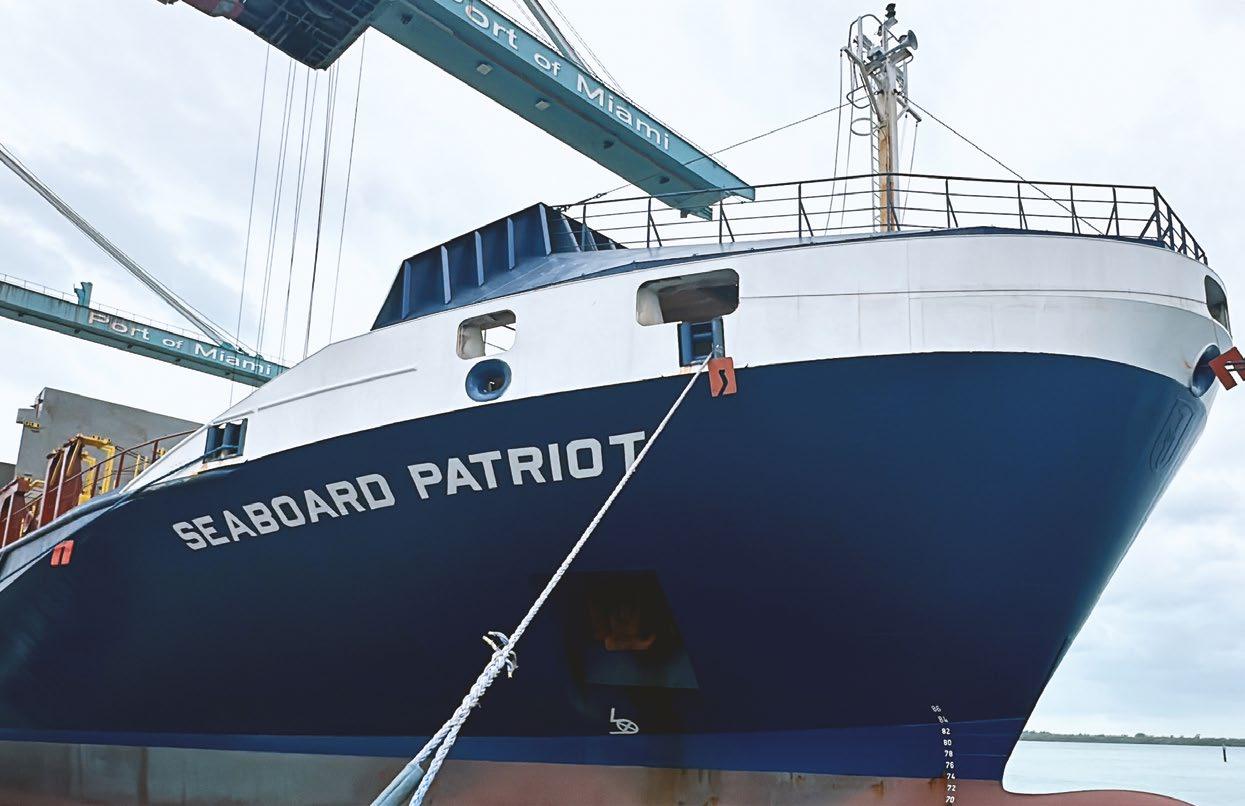
AT THE END OF THE YEAR 2023, WILHELMSEN AHRENKIEL SHIP MANAGEMENT CONDUCTED THE ANNUAL ISM SHIP SHORE EXERCISE.
By Danylo Myachyn
The vessel involved in the exercise was the SEABOARD PATRIOT, a container ship registered in Monrovia, Liberia, which is regularly calling at the port of Miami/USA and relatively recently joined our Management.
The scenario for the exercise is different from year to year and shall cover various potential difficulties that are in some cases overcomplicated intentionally. In order to cover different segments of the response needed, it was agreed with the Master to act as per the simulated incident in the engine room, where a crane wire broke, causing a spill and injuring a crew member. Responding to such a situation required multiple activities in different areas to be performed both on board and ashore. At the same time,
the overall aim of the exercise was to ensure the fulfilment of the ISM Code Chapter 8.3 requirements, which state that the SMS should provide measures to respond to hazards, accidents and emergency situations involving its ships.
The SMS should provide for measures ensuring that the Company’s organization can respond at any time to hazards, accidents and emergency situations involving its ships.
International Safety Management
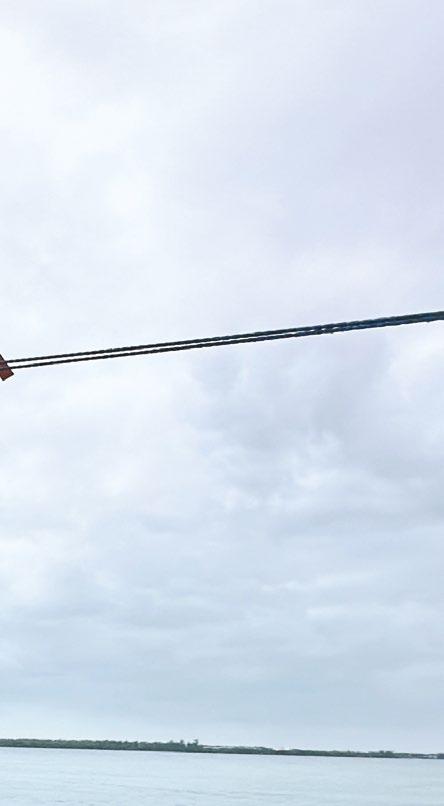
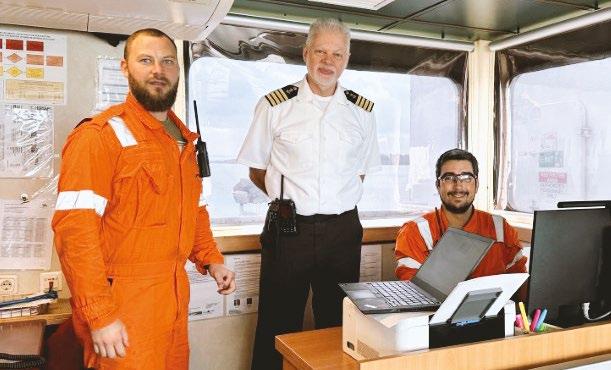
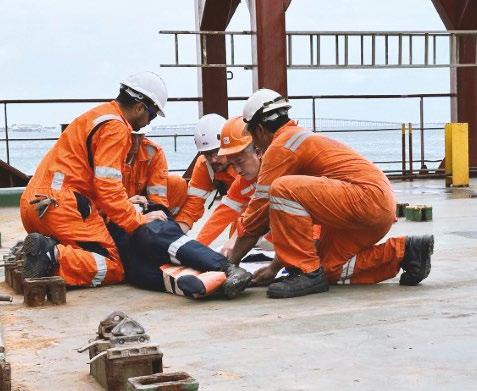
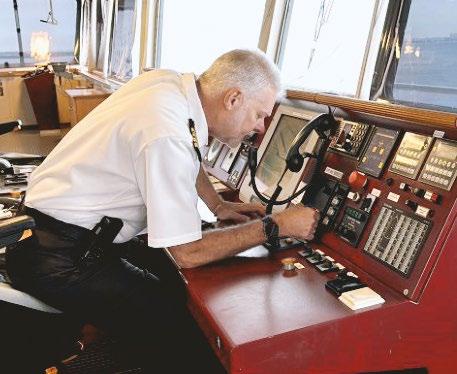
Due to the specifics of the chosen scenario, the amount of the participants was extended involving both internal and external parties, like the DPA/deputy DPA, representatives of the Liberian Flag Administration, Qualified Individual, Class Society, Crewing Manager, Media response, Owner/Charterer, and Radio Medical Advice.
The course of the exercise proved the ability of the crew and shore management team to carry out a response action plan in a short period of time. At the same time, potential difficulties were identified when it comes to the evacuation of the injured person from several locations of the vessel that are much limited in regards of access. That said, it is vitally important for the crew to be aware
of the shortest and safest route to bring the casualty to the open deck where the professional rescuers may pick up and transport the injured person. Container carriers are even more limited, since in most cases, the cargo is occupying the open decks.
As part of the training, emergency backup channels were tested, such as video calls with the Flag Administration Duty Officer, the Company emergency team response arrangements in presence and remote, and not least important – the preparedness of third parties and contractors to respond.
The findings of the exercise included the need for regular evacuation drills and the identification of the easiest and fastest routes for
evacuation from the congested spaces and the engine compartment in particular. The communication part of the exercise was found to be efficient for both the vessel and shore. The aim of the exercise was considered fulfilled.
We appreciate Captain Rodriguez and his professional crew of m.v. SEABOARD PATRIOT for the deep involvement and support rendered during the exercise.
WILHELMSEN AHRENKIEL SHIP MANAGEMENT (WASM) SUPPORTS THEIR VESSEL OWNERS WITH NEW TECHNOLOGIES AND RELATED RETROFIT PROJECTS TO FOLLOW THE PATHWAY OF REDUCING EMISSIONS AND TO MAKE NET ZERO SHIPPING A REALITY BY 2050 AT THE LATEST.
By Dipti Ranjan Nanda, Murad Ismayilov, Uwe Lange, Eckard Rogg, Oleksandra Tabakar
Team
WASM has a dedicated Technical Projects Team, which is part of the Performance Department, to fulfil project objectives defined together with the vessel owners and to perform comprehensive project management. The
team consists of seven members, with various types of experience and skills, including one senior project manager, two vessel managers, one fleet performance operator, one project assistant and two field electricians.
Our services
With our technical expertise in shipping, we offer vessel owners customised project management solutions. At our company, we evaluate potential risks in the project by conducting feasibility studies and offering cost-effective
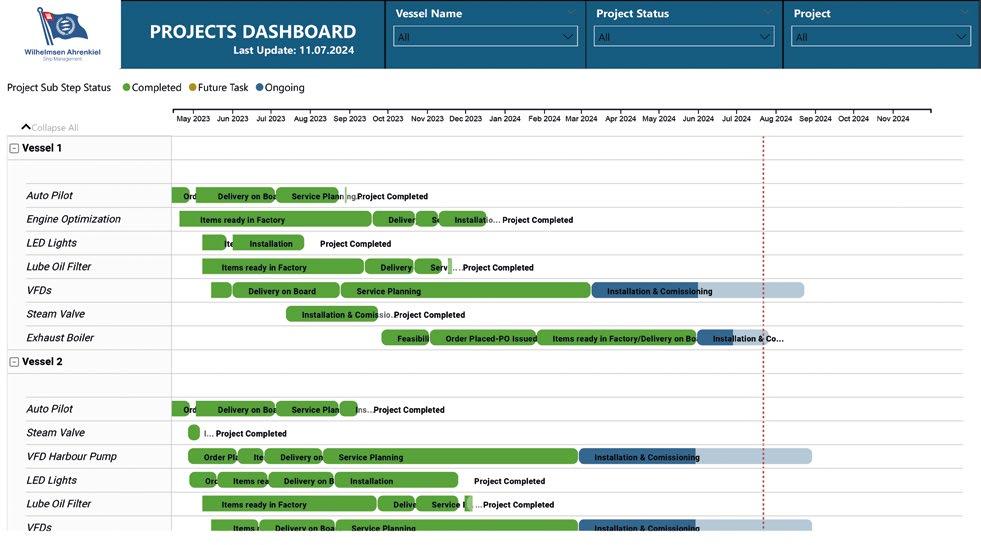
solutions to our customers. We also utilise project management and BI tools for tracking projects in a timely manner and controlling costs.
When it comes to logistical challenges, our global purchasing team provides commendable support to find the most economical solution, keeping the required time frame in mind.
Besides this, our team has an excellent rapport with various classification societies, and we have not faced any unsurmountable challenges. Being primarily a ship management company, there is also an advantage of familiarity
with the class society surveyors in most important locations in different countries. Engagement with class surveyors has made us richer in experience and knowledge.
We focus on the operational efficiency of equipment with new technology, which leads to a visible and measurable improvement in the operational capabilities of the vessels. We realise that with these measures, the overall performance of the vessels becomes dependable to achieve the rigorous demands of the container trade, reduce fuel consumption, and economise on operational costs. There is a
high interest among stakeholders in continuing with the following projects in order to obtain incremental improvements in energy saving (see below).
The Project Team has supervised the installation of the mandatory Shaft Power Limitation (SHaPoLi) system in the fleet to comply with the Energy Efficiency Existing Ship Index (EEXI). We have also launched a sensor-driven performance monitoring system on more than 50 vessels, which enables us to evaluate vessel efficiency in more detail and examine its related impact on minimising our fleet’s emissions and operational costs.
• Improvement in main engine efficiency by adopting new technology to achieve the best possible combustion in propulsion.
• Adopting an optimum design to install exhaust gas boilers to utilise energy from exhaust gases of the auxiliary engines.
• Upgrading of auto-pilots to achieve a nearperfect and straighter sea route.
• Using Variable Frequency Drive (VFD) technology to minimise electrical load for operating the seawater pumps, freshwater pumps, and ventilation blowers when vessels are at anchorage or at port.
• Installing fully automated steam valves to minimise the steam demand for preheating of the main engine jacket cooling water when vessels are at port or at anchorage.
• Installing specially designed lube oil filters, which improve lubricating oil quality and reduce the load on lubricating oil purifiers.
• Installing LED lights that reduce electrical load and improve luminosity.
• Alternative Maritime Power (AMP) to connect vessels with shore power while in ports by 2030.
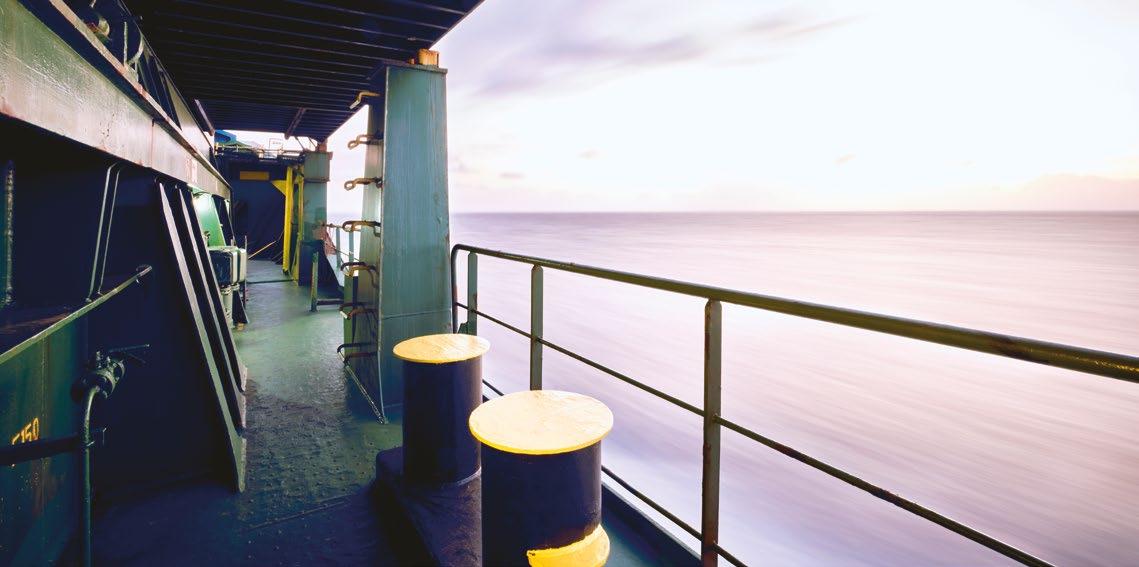
In 2024, our vessel owners decided to increase the uptake of energy-saving devices. We plan to install waste heat recovery systems, which are exhaust gas boilers operating with the exhaust gases of the auxiliary engines on several vessels. This measure will reduce fuel
consumption, especially during port stays, and will allow for a decrease in emissions. The bar charts below illustrate auxiliary engine loads and possible fuel oil savings in tons per month for one of our vessels with the utilisation of an exhaust gas boiler connected to auxiliary engines.
The total consumption of the existing standard boiler is up to 38 tons per month. As can be seen from the second graph, the exhaust gas boiler project using exhaust gases from auxiliary engines is a reasonable investment with a possibility of up to 15-20 tons of fuel savings per month.
Recently, we finalised the feasibility study on exhaust gas boilers and evaluated the technical aspects of the project before installation. The 3D scanning for the feasibility study looks as follows (see below).
Summary
We are well aware that the marine industry is geared up to
adopt new technologies to minimise emissions. But there are a lot of factors that need to be considered including challenges and risks. We consider technical challenges in detail at the project planning stage and are addressing them in discussion with owners, manufacturers, class, and ship staff on board.
Overall, we trust in our people and their expertise, along with the well-structured procedures inside our company, to provide excellent service and tackle the issues that lie on the horizon.
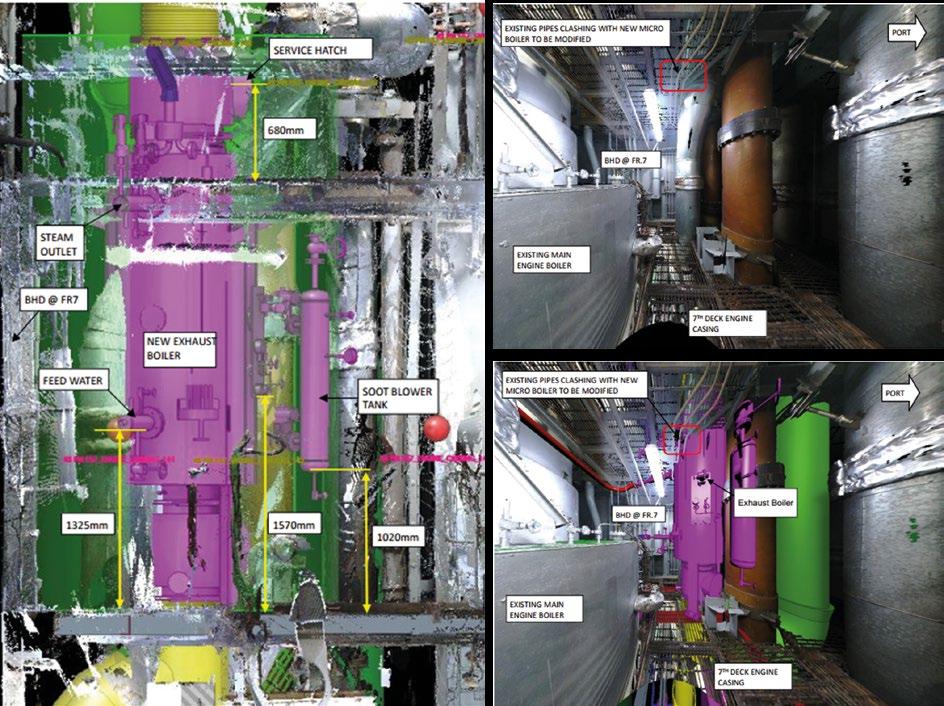
WE AIM TO PROVIDE AN OVERVIEW OF THE EU EMISSIONS TRADING SYSTEM (EU ETS) FROM THE FLEET PERFORMANCE DEPARTMENT PERSPECTIVE WITH THE FOCUS ON DATA. BESIDES THE INCREASED IMPACT OF AN EFFICIENT VESSEL OPERATION, WE ARE FACING HIGHER REQUIREMENTS FOR THE AVAILABILITY OF NOON REPORTING DATA WITH HIGH DATA QUALITY.
By Marc Reinhard, Anuroop Chopra, Mehmet Keles, Liria Klement
Proper leg-based data quality at a verifiable level needs to be ensured nearly on a daily basis, which will enable our clients to monitor their required EU Allowances (EUA) on trustable data. This can only be achieved by the use of proper software tools including reviewed and adjusted data flow processes. The further involvement and training of the crew is key as well. The fleet performance team of Wilhelmsen Ahrenkiel Ship Management (WASM) started preparation together and aligned with owners and partners well in advance. WASM has 14 vessels that are under EU MRV / EU ETS regulation at the time of this article.
The EU ETS is called a cap-andtrade system. A cap is a limit set that aims to reduce greenhouse gas emissions (GHG) for installations, aircraft operators and shipping companies. A certain number of emission allowances are allocated under the cap, and these are reduced annually in order to fulfil the EU’s goal of reducing GHG emissions by 55% by 2030 compared to 1990 and to get to net zero by 2050.
Shipping companies have been included in EU ETS as of 2024 by the EU legislative bodies. According to directives, shipping companies are obligated to
surrender their EU allowances (EUAs) by 30 September 2025 for emissions reported in 2024. It will span over three years and gradually increase each year, starting at 40% of emissions reported for 2024, increasing to 70% of emissions reported for 2025, and finally to 100% of emissions reported for 2026 and beyond. This directive comes into effect for cargo and passenger ships of or over 5000 GT from 2024 and offshore ships of or over 5000 GT starting in 2027. Currently, only carbon dioxide emissions are covered by the EU ETS, but starting in 2026, emissions of methane and nitrous oxide will also be covered.
Under EU ETS, 100% of the emissions for legs between EU/EEA ports and 50% for legs entering or leaving EU/ EEA will be taken into account.
Some non-EU ports will be considered as transshipment ports for container vessels and not defined as ports of call; therefore, the previous or following leg will also be considered and subject to 50% emissions. Currently, Tanger Med (MAPTM) and Port Said East (EGPSE) are defined as transshipment ports by the EU.
Data is key
Positioned close to ship owners, charterers, our technical teams and data verifiers, we serve as the central hub for data, facilitating collaboration and alignment among all stakeholders.
Through our centralised reporting solution, we ensure the delivery of dependable and precise data, enhancing trust and cooperation. While reporting for IMO DCS and EU MRV is annual for compliance purposes, the EU ETS introduces a significant shift in data management to the industry. Precise voyage data needs to be available for shorter periods to calculate the emission allowances. It requires daily and accurate handling of reported data due to the necessary cooperation between owners and charterers to settle the costs for emissions.
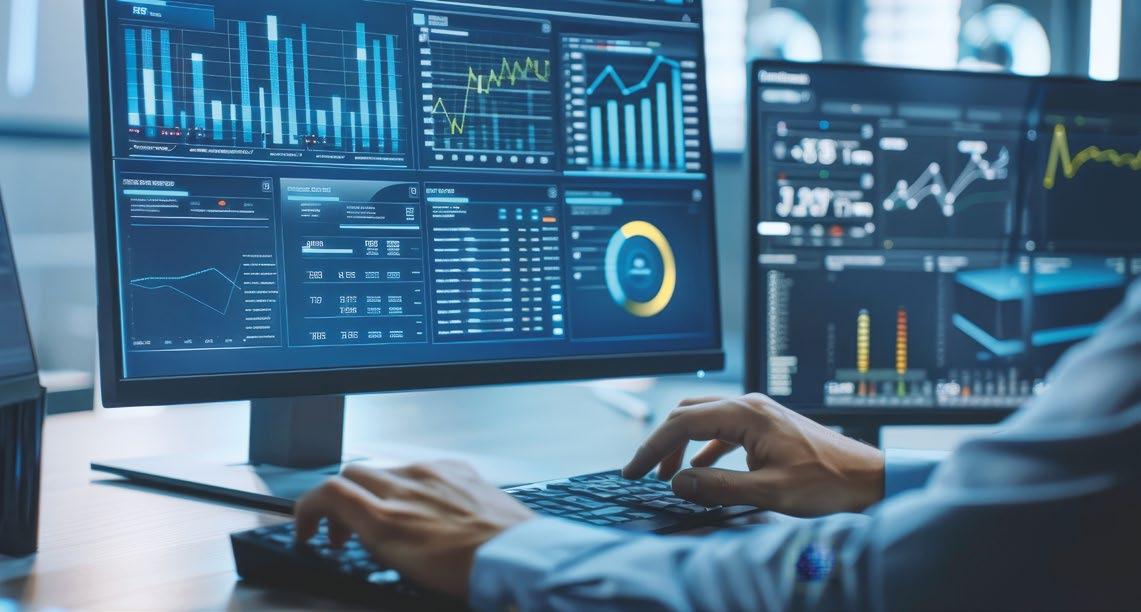
Looking at the data for 2023, we operated 65 vessels and received around 47,500 vessel reports. These reports included a total distance travelled of 4,267,930 nautical miles and in total 5,786 port calls. These values highlight that, ultimately, the whole landscape of data acquisition and integration needs to work efficiently to handle this amount of data.
It needs to be highlighted that the whole process begins with the crew members, who manually report data in the reporting solution, which is the most critical part regarding data quality. The crew is responsible for ensuring that data is reported in a timely and consistent manner, which requires an understanding of the reporting requirements and procedures. For this purpose, we are conducting
crew briefings for senior officers each time they join the vessels and our crew seminars have helped us get good feedback from our crew in terms of optimising ship energy efficiency.
Additionally, the Fleet Performance Department on the shore side is providing guidance and feedback on the reported data to the crew, supported by BI solutions that help visualise and analyse the data..
At WASM, we recognise the paramount importance of data as a valuable asset. In light of the increasingly complex emission regulations expected in the maritime industry, we are constantly reviewing and adapting our processes and set up to meet changing requirements.
We know that everyone involved must work together with the common goal of reducing emissions. Let‘s go for it!
STARLINK IS A SATELLITE INTERNET SERVICE CREATED BY SPACEX, THE AEROSPACE COMPANY ESTABLISHED BY ELON MUSK. IT OFFERS HIGH-SPEED INTERNET FOR THE MARITIME SECTOR, WITH LOW LATENCY AND A POTENTIAL SPEED OF 220 MB/S AT SEA, EVEN IN THE MOST FARAWAY WATERS AROUND THE WORLD. WITH THIS IN MIND, THE PROSPECTS ARE GOOD – IT WILL FEEL LIKE YOU’RE RIGHT AT HOME!
By Sophie Simov
AS Penelope was the first vessel to try out Starlink as a test vessel, and the system went live in late June 2023. Later that year, five more vessels, that were newly taken into Technical Management, got Starlink and improved their on-board connectivity after months of a challenging communication setup on board. The equipment has a small package size and the crew on board installed it with the help of the vessel’s IT Coordinator.
For the time being, vessels are equipped with Starlink as an additional carrier, along with the preexisting connectivity solution, so these vessels then operate with VSAT and Starlink. This sets sail to collect necessary long-term experience on the benefits and potential challenges of the system:
Benefits in a nutshell:
• Improved connectivity and bandwidth, allowing faster and more reliable access to the internet, email, social media, video calls, and entertainment with the aim of supporting crew welfare
• Increased coverage and availability, especially in remote areas where traditional VSAT may not work well or at all.
• Enhanced safety and security, as Starlink can provide backup and redundancy in case of communication loss on other carriers.
Please find below feedback from AS Penelope (Captain Radev & the crew). “Based on 9 months of experience using Starlink as an internet provider on board, the crew have the opinion that it is a huge step forward in terms of connectivity, fast data transfer and browsing compared to the previously used VSAT internet. One well-known issue has been resolved – before, whenever a few of the crew members were on video calls with their loved ones or started a download, the connection for the rest of the crew became impossible, even a simple voice call. Now, with Starlink, this problem does not exist anymore. No matter how many crew members are communicating with their family or using it for entertainment, all the other consumers will have no disturbance in their Internet connection at all.”
Nothing is perfect, and the same applies for Starlink. Apart from the missing long-term experience for this new technology, the system comes along with some limitations. The map below, extracted from the Starlink webpages, shows certain areas of the world in which Starlink does not offer service or where service is still to be activated..
Although it is tempting to stay online longer with this high-speed
internet connection, safety is of high importance and neither work nor rest hours should suffer from this highly appreciated service.
implementation
Stay tuned. MPCC annouced already in their Christmas letter that they have agreed to implement Starlink for all related vessels in 2024 to improve on-board connectivity for the crew and allow for better communication with loved ones.
Seaboard Marine decided to implement Starlink on board selected vessels to replace old communication setups. Hopefully, more to come.
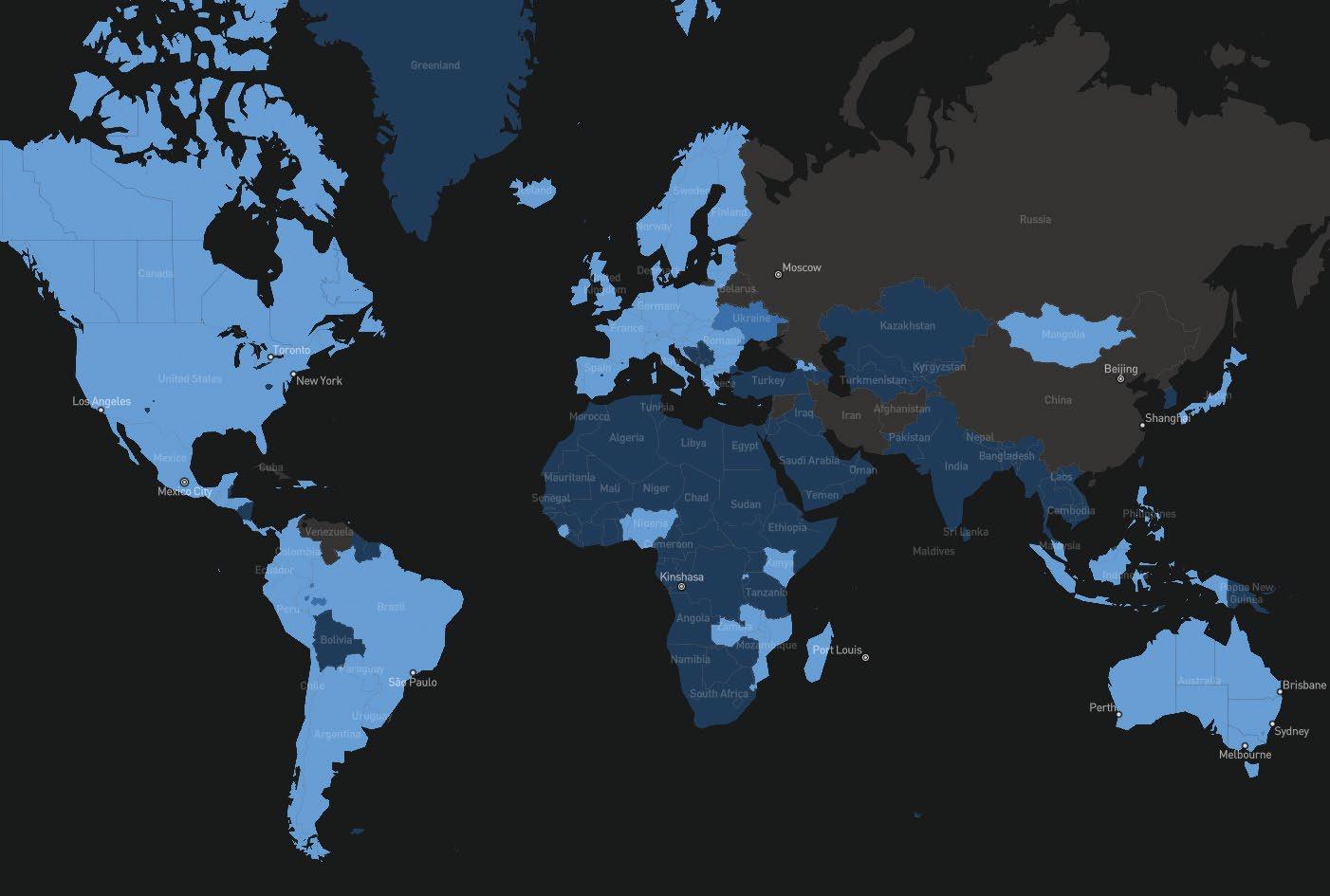
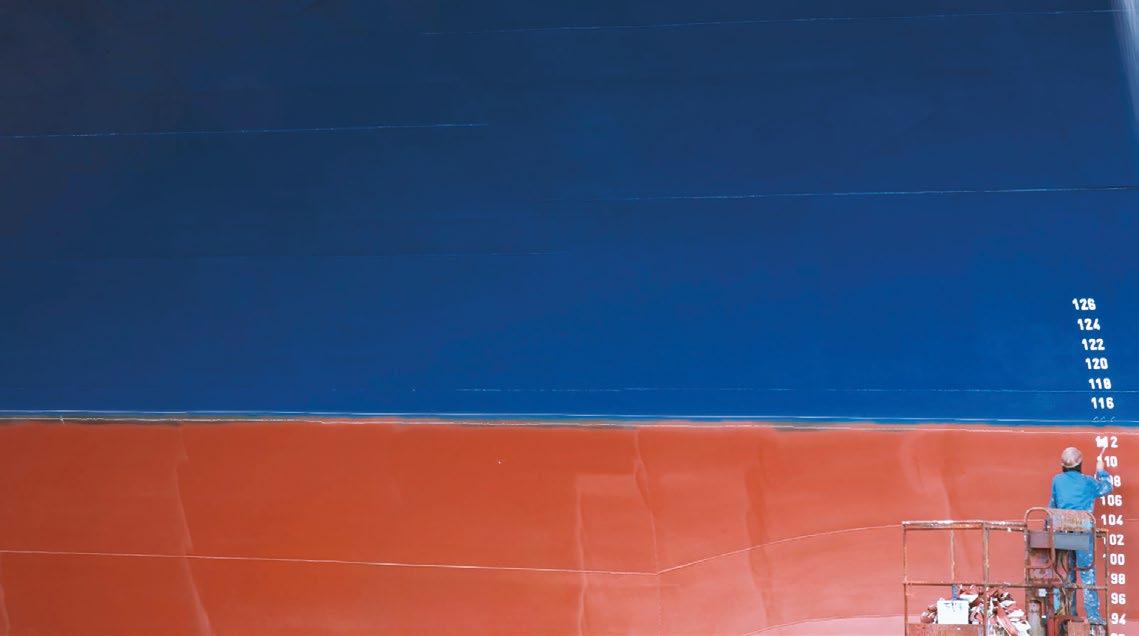
PAINT APPLICATIONS ON VESSELS ARE AN ESSENTIAL PART OF THE MAINTENANCE AND REPAIR PROCESS IN DRYDOCK. PAINTS NOT ONLY PROTECT THE HULL FROM CORROSION, FOULING AND ABRASION, BUT ALSO ENHANCE THE HYDRODYNAMIC PERFORMANCE AND FUEL EFFICIENCY OF THE VESSEL.
By Harm Mulder
However, paint applications also pose significant environmental and economic challenges, as they involve the use of hazardous substances, generate waste and emissions, and require time and resources.
From the early days when the ancient Greek built their famous warships to the period of the Dutch shipbuilders in the 17th century, ships were already coated to protect the wooden hull from water damage.
Before a “dry dock” had been invented, ships were usually laid to one side to apply a protective layer. They used tar, copper or other binding materials to protect the hull against water and later against marine growth..The first Dry Dock, designed by an Englishman named
Mr Perry, was built in Holland in 1705. Ships were easier to maintain in the underwater area and protection could now easily be applied on the hull.
19th to mid-20th Century
During the pre-regulatory phase (before the 1970s), paint applications on vessels in drydock were mainly based on conventional solvent-based paints (alkyd, epoxy and polyurethane). These paints contained solvents that emitted chemical gases (Volatile Organic Compounds). This provided good protection against marine growth but contributed to air pollution and ozone depletion.
Later, the industry invented a very effective anti-fouling paint, which contained metallic compounds (named TBT). Effective, but harmful to underwater sea life and to the food chain.
Methods of paint application were mostly manual, such as brushing, rolling and spraying, which resulted in low efficiency and high waste generation. At that time, the impacts of paint applications on the environment and human health were largely ignored or underestimated.
After 1970, more and more regulations came into force to protect the environment, starting in 2001, with the ban of anti-fouling paint with tributyltin (TBT) and lead contents, described in The International Convention on the
Control of Harmful Anti-fouling Systems on Ships (AFS Convention). These regulations aimed to reduce the environmental and health risks of paint applications.
The types of paint shifted from solvent-based to water-based or high-solid paints, which had lower Volatile Organic Compounds content and were less toxic.
The methods also improved with the introduction of automated and robotic systems, which increased the efficiency and quality of paint applications and reduced waste and emissions.
millennium
Paint applications are driven by the need to further enhance the environmental and economic performance of paint applications, as well as to meet the increasing demand for new features and functions of paints. The types include advanced coatings, such as nanocoatings, biocidal coatings, self-healing coatings and smart coatings, which offer superior properties and functionalities, such as corrosion resistance, fouling prevention, self-repair and sensing. The methods also involve novel techniques, such as plasma spraying, electrostatic
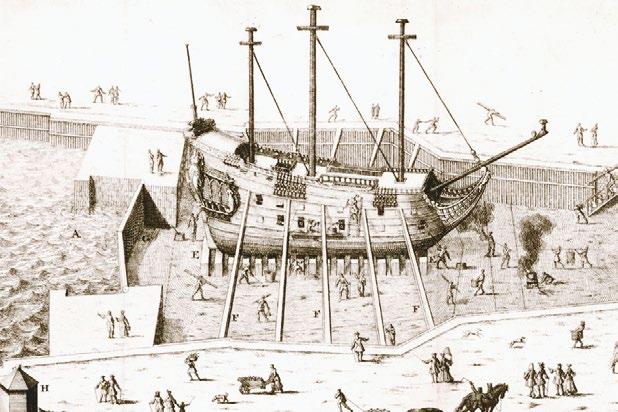
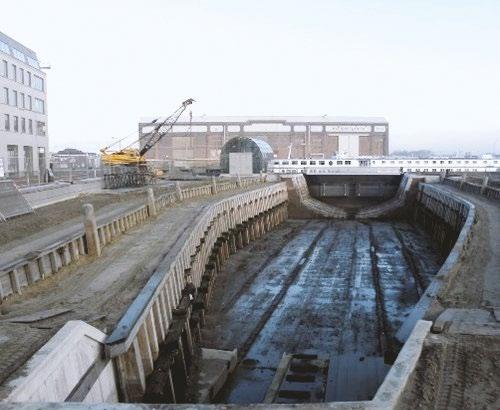

spraying and ultrasonic spraying, which enable the formation of thin and uniform layers of paint with minimal waste and emissions.
The implementation and harmonisation of global and regional environmental regulations and standards will set the criteria and limits for the environmental and health impacts of paint applications from now on. Environmental regulations will become stricter, not limited to the product of paint itself, but also for the pretreatment of the underwater surfaces in dry dock as well as the disposal of the old paint.
There is a rapid development of new paint types, taking the key criteria into account:
• Environmental regulations.
• Economic performance, by means of speed and fuel oil consumption.
Based on these criteria, Wilhelmsen-Ahrenkiel recommends that ship owners conduct optimum pre-surface preparation of the underwater hull by means of full blasting, together with an application of a high-performance paint type.
History has showed much development that tells us this will continue in the future, with the aim of contributing to a better environment.
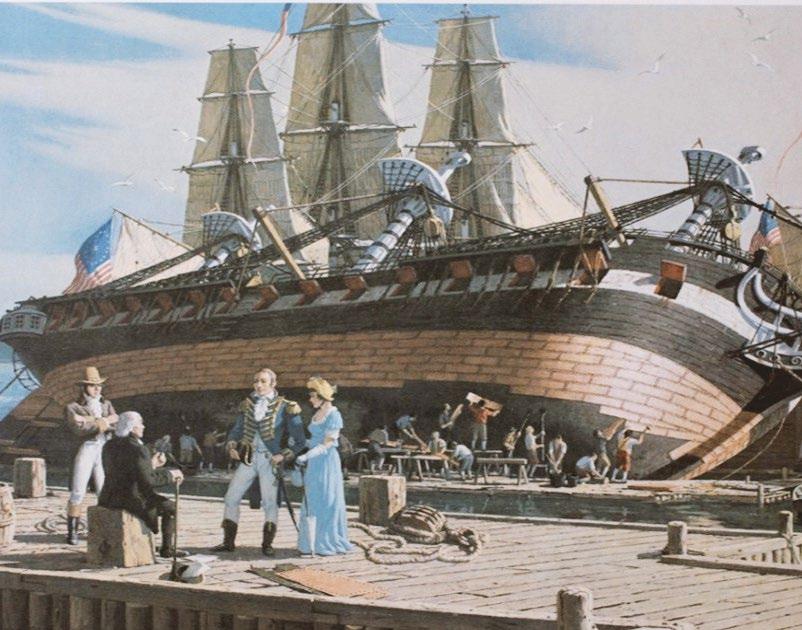
SOMETIMES EMAILS ARE SENT WITH THE POSITION „TRAINEE“ IN THE SIGNATURE. BUT WHAT DOES THIS POSITION ACTUALLY ENTAIL? MANY PEOPLE ASSUME THAT THIS PERSON IS STUDYING AND WORKING PART-TIME AT WILHELMSEN AHRENKIEL SHIP MANAGEMENT, AS IS COMMON PRACTICE IN OTHER COUNTRIES AND, OF COURSE, IN GERMANY.
By Laura Paschburg
But doing an apprenticeship in Germany means much more than that. There are similar forms in other countries, but the German system is very extraordinary and more or less unique. That is why there is no correct translation for the word we use in German for the person who completes such an apprenticeship. It is often translated as “trainee” or “apprentice”, but this sometimes means something different in English than what is meant in German.
When you finish school in Germany, you can decide to go to university or do an apprenticeship. There are a variety of professions, and you apply in the same way as you would for a permanent position. There is an interview and possibly an assessment centre
and at the end, if you are accepted, you sign the apprenticeship contract. You are then permanently employed by the company for a period of 3 years and receive a salary that is lower than that of permanent employees, as you work full-time but are still learning and have to gain work experience first. During the 3 years, you pass through many departments in the company in order to be comprehensively trained in the profession. At Wilhelmsen Ahrenkiel Ship Management, you usually start in one of the technical teams. You work together with the Vessel Managers and Technical Assistants and get an insight into how the permanent employees work.
After becoming familiar with the technical department, you usually
move to Harper Petersen, which offers a wide range of shipbroking and commercial chartering services of container vessels, and you work there in the Operations Department for a few months.
In other words, you look at the commercial side of shipping there. The cooperation with Harper Petersen is due to the fact that both companies belong to the MPC Group, so that the trainee can be offered comprehensive training.

Later in the apprenticeship, you will accompany the Harper Petersen chartering team for some time in their day-to-day work, giving you an insight into the commercial business, charter negotiations and the conclusion of contracts.
However, you spend most of your training in different departments at Wilhelmsen Ahrenkiel Ship Management. You can take a look at the world of crewing, work with colleagues in the insurance department, learn about their work in HSEQ and, most recently, you can also visit the performance department and gain an impression of how important ship reporting has become. You usually spend between a few weeks and a few months in each department, which gives you
a deep insight into the work of your colleagues. Of course, you are still learning the job during your training, but in many departments, you are already allowed to take on a lot of responsibility, work on projects and communicate e.g. with the ships, so that, as mentioned at the beginning, an email with the signature “Trainee” arrives in your email inbox.
Now that COVID-19 is hopefully a thing of the past, the trainees are allowed to spend some time on board one of the ships in the fleet during their training to gain an insight into the work on board and later have a better understanding in the office of how the processes on board work and what to look out for. Many of the trainees come into this profes-
sion straight from school and usually have no nautical or technical background. So, it’s a great advantage if you can visit a ship, even if it’s just for a day in the port of Hamburg or Bremerhaven.
What also makes training in Germany so special is that you go to vocational school twice a year for six to eight weeks during the three years of training. (This can be shortened to 2.5 years if you perform well.) All trainees from various companies in Hamburg come together at this school in the centre of Hamburg. There are also classrooms, just like at school, and you acquire a lot of background knowledge and theory together with your classmates, as the school is a vocational school with specially trained teachers.
There you learn about the many different types of ships and technical specifications as well as the various contracts in shipping, container dimensions, laytime calculations, charter parties, flag law, marketing in the liner sector, the names of the bulker and tanker sizes as well as all the seas and straits in the world, the planetary wind system, important ports worldwide, but also a lot of bookkeeping and business accounting. You also learn a lot about German labour law, trade unions, insolvencies, and various types of companies, as well as INCO terms and specialist English lessons.
Trainees in the shipping industry therefore receive very comprehensive training, which means that they are very well trained for the professional world after their written and oral examinations at the end of the training period. They will also have gained the necessary professional experience so that they can apply for a permanent position in a shipping company or be taken on as a permanent employee in their desired department at Wilhelmsen Ahrenkiel Ship Management or Harper Petersen.
This has the advantage for both sides that the trainee knows the company and the processes, and the company already knows the employee, which is often not the case for people who have completed a bachelor’s or master’s degree at a university and are new to the company and the world of work.

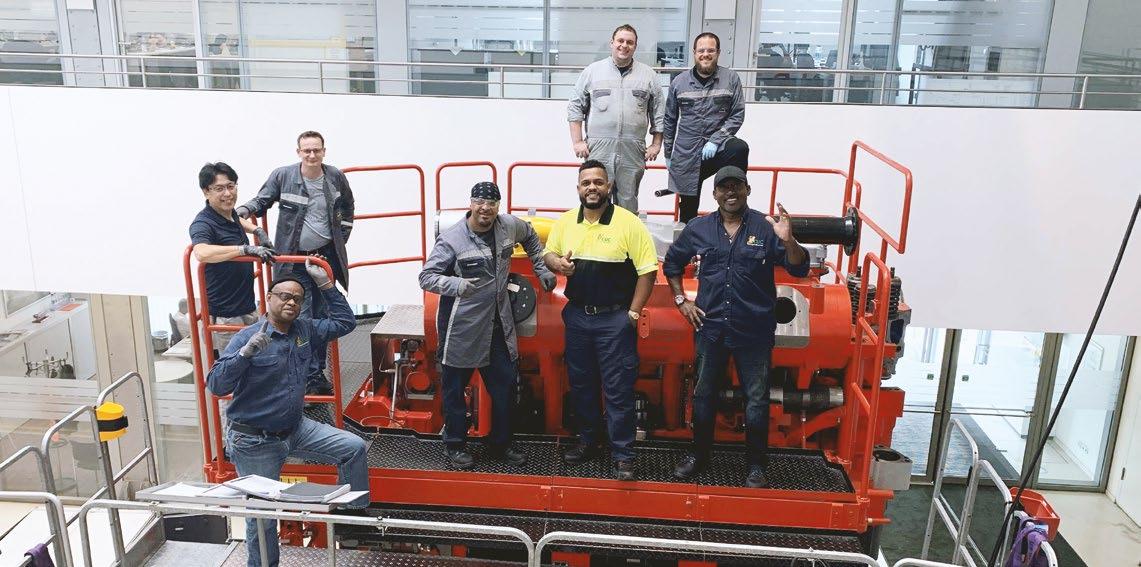
By Enrico Rupp and Dmitry Boychuk
On the way to Augsburg, we expected that the Engine Expert Maintenance Course was going to be another boring theoretical course. But when all the students finally came into the classroom, we found ourselves in the wrong place – we clearly did not belong! Everyone, including our instructor Lukas Matt, was dressed up in a boilersuit and ready for real action – except for us. And our boredom immediately disappeared after we were told that we were to be given working cloth and work on the engine. So, we worked on the engine.
Our team was very international and professional at the same time. The weather was bright and warm. The food and… - Sorry, I should stop here, the story is about training. We should keep on track. So, heavy iron parts have been lifted and carried, dis-
mounted and re-mounted. Cylinder head, top land ring, piston with conrod, supporting ring (cooling water jacket) with liner…
I hope all those part names sound familiar to our colleagues. If not, maybe you are next to attend this course! The work went very smoothly as every nut and bolt was unscrewed and screwed on again – no one can say how many times. The engine was wiped a thousand times with student’s boilersuits and rags, so you can imagine how clean and shiny it was.
In between, when heavy parts had been lifted and lowered, we had the chance to inspect all the removed parts. There was also a set of used and damaged bearing journals and we had to find the right answer to what was the cause of the damage.
As a bonus for a job well done, we were rewarded with a visit to a 4-stroke engine factory. Unfortunately, using a camera or phone was not allowed there. Hence, it is up to you to believe us or not, but we saw the engine production process from A to Z. To wrap up our story, we would like to thank our management for the great opportunity to refresh our skills, expand our knowledge and meet very nice people from all over the world.
A lot of thanks are also due to the Academy of the engine manufacturer for the very warm welcome and hospitality, for the good presentation and the experience shared with us.

By Susanne Petkovic
I wanted to try something different from the usual crew conferences that we have been having for over 30 years. I chose to organise a “Fishbowl”. This name comes from the way the seats are arranged for the participants. There is a circle with five seats in the middle where the discussion takes place. The topic was “Safety Awareness and Social Mediahow to balance family and fatigue”.
The 30 participants from our fleet were curious when they saw the chairs. It is always interesting to see who sits outside and who inside. The middle five seats were empty at first, as no one wanted to be the centre of attention. This kind of conference needs a good moderator to encourage the participants to share their opinions. I asked the first five to sit in the middle. Our captains are always
good for this. At first, I had to guide them a bit as moderator, but then the round became livelier. Anyone who wants to join the discussion stands up, taps one of the five middle participants on the shoulder and switches seats. Only the inner circle can discuss. We discussed the topics for almost two hours and the clapping at the end made me feel very good. We will do it again.
A fishbowl conversation is a method of facilitating group dialogue and discussion. It involves a small group of people seated in a circle, having a conversation in full view of a larger group of listeners. Some of the advantages of using this format include:
• Encouraging participation: The fishbowl format allows for a more structured and focused conversation, which can encourage participation from individuals who may not feel comfortable speaking up in a larger group setting.
• Promoting active listening: The listeners in the outer circle are encouraged to actively listen to the conversation taking place in the inner circle, which can help promote understanding and empathy.
• Facilitating deeper discussions: The fishbowl format can help to facilitate deeper and more meaningful discussions, as the smaller group size and structured format can allow for more focused and in-depth exploration of topics.
• Inclusivity: The fishbowl format can be an effective way to ensure that all voices are heard and that the conversation is inclusive, as it allows for a diversity of perspectives to be shared in a structured and respectful manner.
Overall, the fishbowl conversation format can be a powerful tool for facilitating group dialogue and promoting active listening, participation and inclusivity.
DUE TO THE CHALLENGES POSED BY COVID-19 AND THE UKRAINE WAR, IN 2021 WILHELMSEN AHRENKIEL SHIP MANAGEMENT DECIDED TO COLLABORATE WITH MENTAL HEALTH SUPPORT SOLUTIONS (MHSS).
By Mia-Kaarina Feistner
MHSS is a company that provides psychological and emotional support for seafarers and maritime professionals through a qualified team of psychologists. They offer a 24/7 helpline, online therapy, crisis intervention and mental health training for crew members and shore-based staff.
We started with live lectures by MHSS psychologists held regularly at our various crew seminars to train the participating officers in mental health awareness. Our goal is to maximise psychological well-being on board the vessel under our management and to get trained in dealing with depression,
stress and fatigue. By increasing knowledge about mental health in general and how to improve it, the seminar participants should be able to notice and react to any signs of other crew members who may have a bigger issue and, if needed, get in touch with MHSS. As technical ship managers, we feel responsible for a culture of care on board and want to encourage the crew to address mental health issues without fear of consequences to lessen the stigma that seafarers may face when bringing up their mental health. We are convinced that mental health is an essential aspect of wellbeing and safety in the maritime
industry, not only for the crew onboard but also for our employees ashore. That is why we started offering the same training sessions to our employees in the offices in Hamburg and Rhoon in 2023.
Caring for our employees is important to us and we will continue to raise our employees‘ awareness of mental health in the future.

TALK, EAT, ENJOY AND REPEAT – CATCHY WORDS FROM OUR MANAGING DIRECTORS IN THEIR OPENING SPEECH OF OUR FIRST JOINT SUMMER BBQ ON 14. JUNE 2024. BUT LET US TAKE IT FROM THE BEGINNING.
By Mia-Kaarina Feistner
For the first time, we welcomed our new colleagues from Zeaborn Ship Management to our Summer BBQ. Along with our Wilhelmsen Ahrenkiel Ship Management Hamburg and Rhoon colleagues and the team of Barber Ship Management we celebrated at an event location directly next to the river Elbe. It was our sincere wish that the event would provide us with the opportunity to get to know each other by spending a relaxed time together in a pleasant atmosphere.
But how do we get in contact for the first time? This was a question we were carefully thinking about. We decided to start the evening with a “Get-To-Know-Quiz” and were happy to gain Michael Tasto from MPC Container Ships ASA as extraordinary quiz master. 20 mixed teams with names like “Fish & Ship(s)”, “Highway to Hull”, “Crazy Captains” or “Ready or Knot” were competing to each other to answer the most questions correctly as quickly as possible.
on the Wilhelmsen Ahrenkiel logo. The smell of smoked BBQ began to fill the air already during the quiz, but it was only after we duly celebrated the award ceremony for the winning team that the BBQ buffet was opened. It looked like all were happy to start EATing after the hard mental work and moved on to the convivial gathering with lots of conversation. Everyone could decide whether to ENJOY the great atmosphere outside on the terrace with a magnificent view of the river Elbe – very fitting for a technical ship manager - or inside to keep fingers crossed for the German team at the opening match of the European Football Championship. No matter where, the good conversations continued throughout the evening and in the end the German football team could be cheered for their success.
It was almost midnight when the last guests said goodbye. We look forward to seeing our new colleagues again soon. And coming back to the catchy words of our Managing Directors from the beginning: It is worth a REPEAT! Underwater
As it soon turned out, this would only work as a team by TALKing to each other because hardly any Wilhelmsen Ahrenkiel colleague would know how many steps you need to climb from the foyer to the office on the 15th floor of the Baloise Tower. And hardly any Zeaborn colleagues would have been able to answer the question of which species of fish is depicted
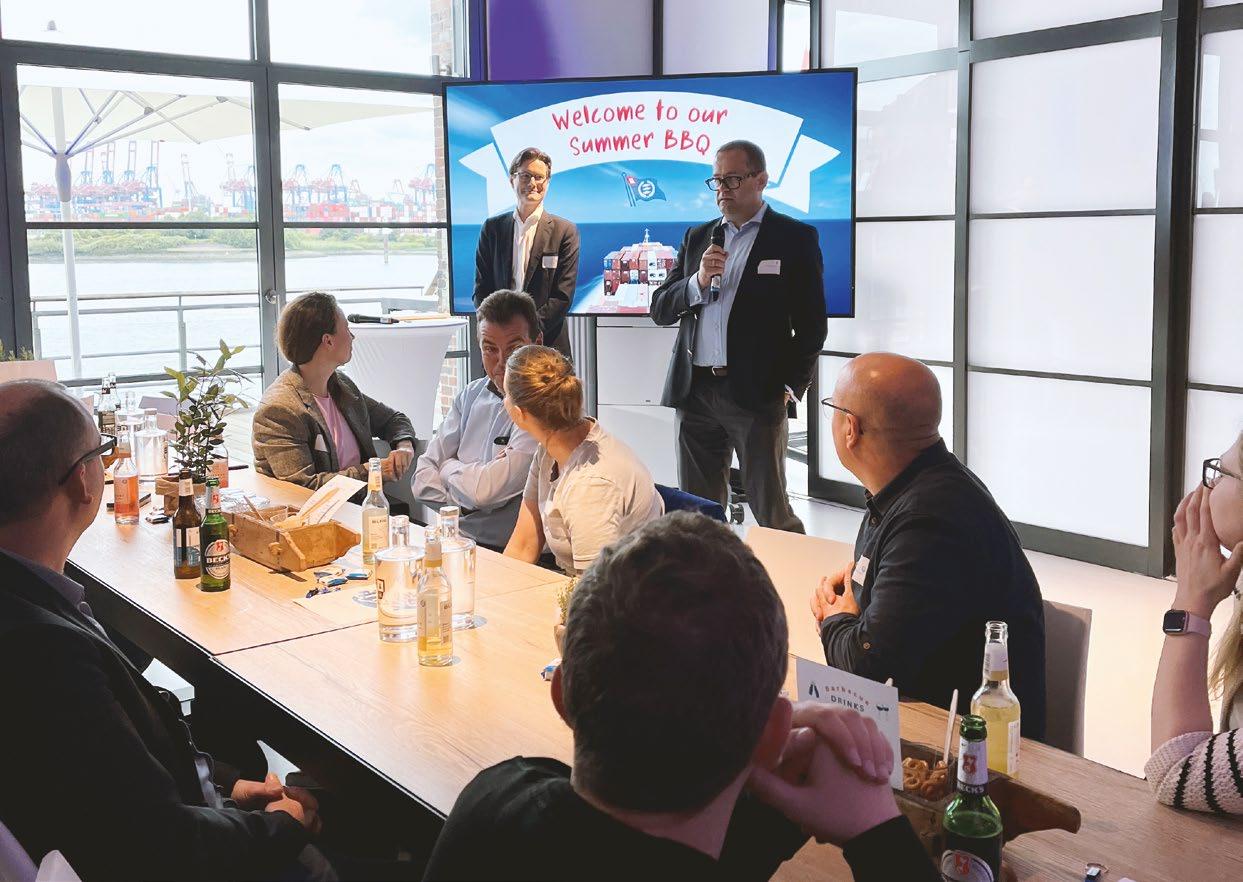
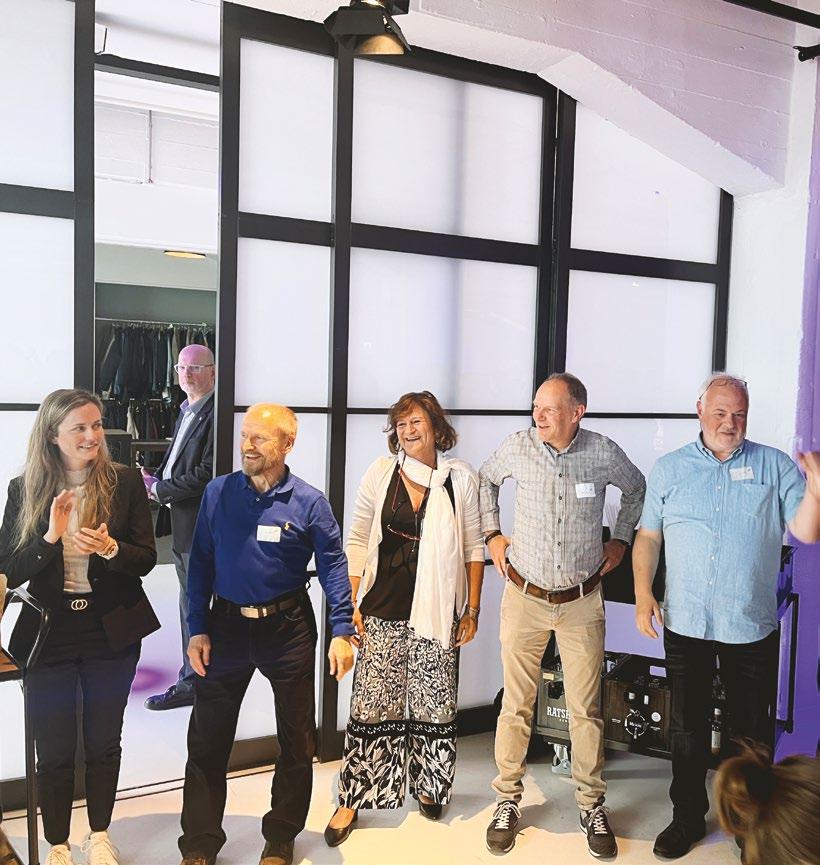
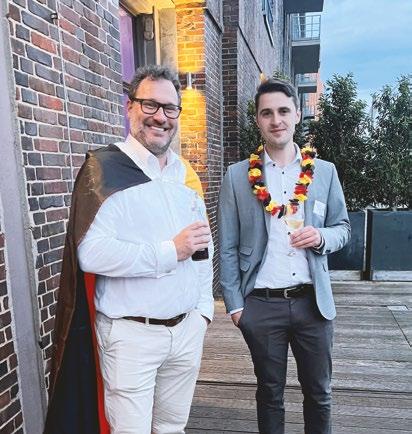
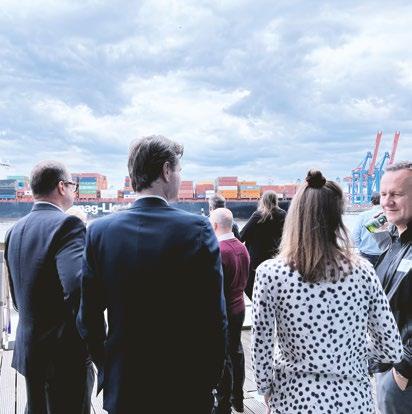
GERMAN IS A COMPLEX LANGUAGE AND, AS WE ARE AWARE FROM OUR FOREIGN COLLEAGUES, LEARNING GERMAN IS A CHALLENGING BUT REWARDING EXPERIENCE. IT OPENS UP NEW OPPORTUNITIES FOR COMMUNICATION AND UNDERSTANDING, ESPECIALLY IF YOU LIVE IN THE COUNTRY.
By Oleksandra Tabakar and Ido Cohen
Introduction
Oleksandra Tabakar and Ido Cohen, two motivated and enthusiastic young professionals who moved to Germany to realise their professional careers in the shipping industry, recently joined our team. Their following stories tell about their personal experiences of learning German, including the surprises and challenges they encountered along the way.
I am Oleksandra and I am currently doing an apprenticeship as a shipping clerk in Wilhelmsen Ahrenkiel Ship Management/MPC Capital. This basically means that I am working as a trainee in different departments and studying in a special school (called “Berufsschule” in German) for several weeks twice a year. All the learning materials, tests and lessons are in German, even the majority of my classmates are German.
I initially come from Ukraine, and as you can imagine, my journey of learning German has been full of surprises and funny challenges. It all started in 5th grade when I had my first German lesson at school. I would say we (the German language and I) had a “toxic love-hate relationship” from the very beginning, due to the constant misunderstanding of each other and challenges we could not overcome together. Seriously speaking, it was difficult to learn the language in an environment of non-native speakers. After 7 years of slow learning, I took a 4-year pause and then 2 years ago fate brought us together again. This time it was love at first sight, and I am full of willingness to speak it fluently one day!
To start with, I knew that there are genders in German, so I was learning everything properly to remember all the rules, but I was definitely not expecting the word “a girl” to have a neuter gender (das Mädchen). Moreover, I understand the structure of the German language and the ways some words
are built make me feel so small in comparison with their length. For example, lots of German words include 2-4 smaller words inside them, for example “Nahrungsmittelunverträglichkeit” (food intolerance). So, I sometimes do the trick of mixing random words and creating a new one and somehow it works! Afterward, I checked if there was such a word, and how surprised I was when I found out that it actually exists!
I had a funny situation happen to me when I had just started communicating with native speakers. I remember someone asked me:
“Hast du einen Freund?”
I was so confused by this question, so I replied: “Sure, I have lots of friends!” Only a few months later, a friend of mine explained to me
why that person looked surprised at my reply. “Hast du einen Freund?” means in German “Do you have a boyfriend?” instead of “Do you have a friend?” as I thought. I had no idea that the word “Freund” in such a context could have another meaning.
One more confusing feature of the German language is the numbers. For example, the number “29” is pronounced as “twentynine” in my mother tongue as well as in English, whereas in German it is “nine-and-twenty”. So, when someone is saying numbers to me, I need time to convert them the other way around! Despite all the confusion and challenges, I do enjoy learning this language, because the more I learn, the more I can understand the culture and people surrounding me every day.
My name is Ido Cohen. I came to Germany on September 1st, 2023, from Israel. My voyage in the shipping industry started when I joined Harper Petersen in mid-September 2023. I worked there in the operations department for a month and a half, until the beginning of November. To gain new experience, I moved to the chartering department for the rest of my contract under Harper Petersen, until mid- December. I have been working at Wilhelm -
sen Ahrenkiel Ship Management in Hamburg in the Insurance Department since December 2023 as an interim on a part-time job for four hours every day, five days a week. After work I am learning German in a language school. In class we talk in German as much as possible. It is tough for me because sometimes I don’t understand what the teacher is talking about and I ask him, but he gives me the answer in German, so I use an online translator from time to time.
Luckily, there are some similarities between Hebrew and the German language, for example:
• Hebrew: meshuga – German: meschugge – English: crazy
• Hebrew: sack – German: Sack –English: sack (a sack of rice for example)
• Hebrew: Peripheries – German: Peripherie – English: suburbs
Still, on the other hand, there are a lot of new words, grammar rules and three articles to learn (der, die, das), which is a big difference to Hebrew in which we only have two (feminine and masculine). The German articles which go with the nouns are hard for me to understand. For example, the article for the noun „Kino“ (cinema) is „das“ (a neutral article) in German but in my mother tongue it is masculine (equivalent to the article “der” in German). To learn the articles is an exciting but also complicated challenge for me. I am working hard and trying my best. Currently, I am at the B2 level.
When I first heard the word “meschugge”, I laughed out loud, because first as I mentioned it is very similar to the meaning in Hebrew and I was happy about it.
In addition, I started to feel more comfortable with the German language because I could understand that there might be more similar words which would make it easier for me to understand the German language better.
I fell in love with Hamburg. The city has a lot to offer, for example, good restaurants and clubs, a lot of sightseeing and beautiful nature, which I like. It’s crucial to learn the German language if you want to integrate properly into the German culture; it also gives you the advantage of knowing more languages, as knowledge is power, of course!
To summarise everything, the German language is challenging and complicated. As with everything else in life, it takes time to understand, but it is doable!! And I will try my best to succeed at school and learn the German language as fast as possible.
BECOMING A CADET ON BOARD IS A STORY IN AND OF ITSELF. OLEKSANDRA TABAKAR DID A GOOD JOB INTERVIEWING SOME OF OUR CADETS ABOUT THEIR STORIES. FROM THESE INTERVIEWS ONE STOOD OUT, AND WE WANT TO SHARE THE STORY OF MARIA MERCEDES BLOOM SANCHEZ – DECK CADET.
By Oleksandra Tabakar
Introduction
My name is Maria Mercedes, and I am from Columbia. My father is a captain working on tanker ships. So, this was the reason I wanted to pursue this career as well. He was in shock when I told him about my intentions, and he told me it is a hard career – it’s not for women. He missed so many important things because of this work – even my birth! However, I am that type of person who does not stop despite the difficulties. I will continue until I win.
But it was hard. As there is no appropriate institute in Colombia it is a real challenge. I had to decide between three options: Spain, Brazil or Panama. I chose to study in Panama, because it’s closer and the people and cuisine are very similar to my home country. Admittedly, it was difficult – I was alone all the time. My attempts to run away from this feeling were unsuccessful, unfortunately, and I had some moments of weakness from time to time. However, I did not give up and I finished university. Finding a Cadet position was also a challenge as companies are
reluctant to give freshly graduated students with no experience an opportunity. One of my friends suggested applying to WASM. I was shocked and nervous when Ms Susanne answered my email immediately. I still wonder sometimes: “What did she see in me to give me this chance immediately?” I am so grateful!
What was the best experience? Any difficulties?
Yes, as well as others, I faced some difficulties due to my inexperience, but it’s okay, you cannot stand crying; you must take notes and continue. Another challenge was the attitude of one of the crew members towards others due to his mental health. He was depressed and stressed all the time because of the war in his home country. Sometimes we felt his negative energy and the influence of these events on him. He decided to be alone and not interact with anybody. Nevertheless, we wanted to support him and help. So, we showed him our good intentions and talked to him a lot to help him get through, and
as a result he changed his behaviour, and everything was good.
Were the expectations fulfilled?
I was with another female Deck Cadet for the first 1.5 months sailing on AS PAULINE, so I did not feel lonely. When she left after 1.5 months I was nervous to communicate with others, because she used to be the one who would ask the questions and approach everyone. Then I understood that I must demonstrate my assertiveness and desire to learn. I asked many questions and as a result, I won this fight with myself and became more confident and sociable.
Who was in charge of mentoring? How was the feedback and learning process?
The Chief Officer and 3rd Officer were my mentors and gave me good feedback. They motivated me to become better. As a result, the Captain pushed me to be the shadow of the 3rd Officer.
I followed him everywhere he went and learned by watching his performance. On AS PALINA I was eveninchargeofassistingthenew 3rd Officer to become familiarised with the vessel because I was already experienced at that time. I showed him the ship and taught him something. It was a valuable experience because I learned as well. Of course, in the event of him making mistakes, I would be the one responsible for them.
What were your responsibilities?
On my first assignment, I was in charge of maintenance of the deck. I was doing watchkeeping with the 3rd Officer. Later my schedule was switched, and I did watchkeeping with the 2nd Officer at night. The responsibilities on my second and third embarkation were the same. I was standing on the bridge from 8 am to 12 pm. Then I did some maintenance tasks with the 3rd Officer and at night again I did watchkeeping.
What is the most important thing that you learned?
We are equals on board. It does not matter what nationality you are, if
you are a woman or a man, etc. We have the same opportunities and the same rights here. It is false if you think that I cannot do the things men usually do. Try me!
What was the most positive thing? Any complaints or bad experience?
I had one impressive experience on board. We were passing between Cuba and Florida and assisted six people who were sinking. We managed to save these poor people. As far as I know, they wanted to get to the USA, but a storm passed, and they lost all the foodandwaterandwereswimming for 10 days in the sea. All the vessels passing through did not offer any help to them. The conditions were poor due to the small size of the device they were swimming on. The captain trusted me with the huge responsibility of calling the coast guard and communicating with them. I think this experience was really important for me.
Any entertainments onboard? Parties?
Oh, yeeeeeees. Karaoke!! I am a bad singer, but Filipinos are professionals and I adore listen-
ing to them. We were watching movies all together with the officers. And of course, Playstation – but I was just a supporter
Differences between 1st and 2nd contracts.
I learned that maintenance is a really important part of your studies because you must know everything as an experienced officer. You have to know every detail of your job and have some general knowledge about engine rooms as well. On Saturdays I was assisting the 3rd Engineer and he taught me about engines and gave me a small familiarization.
The most important thing I wanted to say to WASM is “thank you”. There are not so many girls in this business, but we all keep in contact all the time and share our experiences.
We are so grateful to have this opportunity to work in your company and grow up!
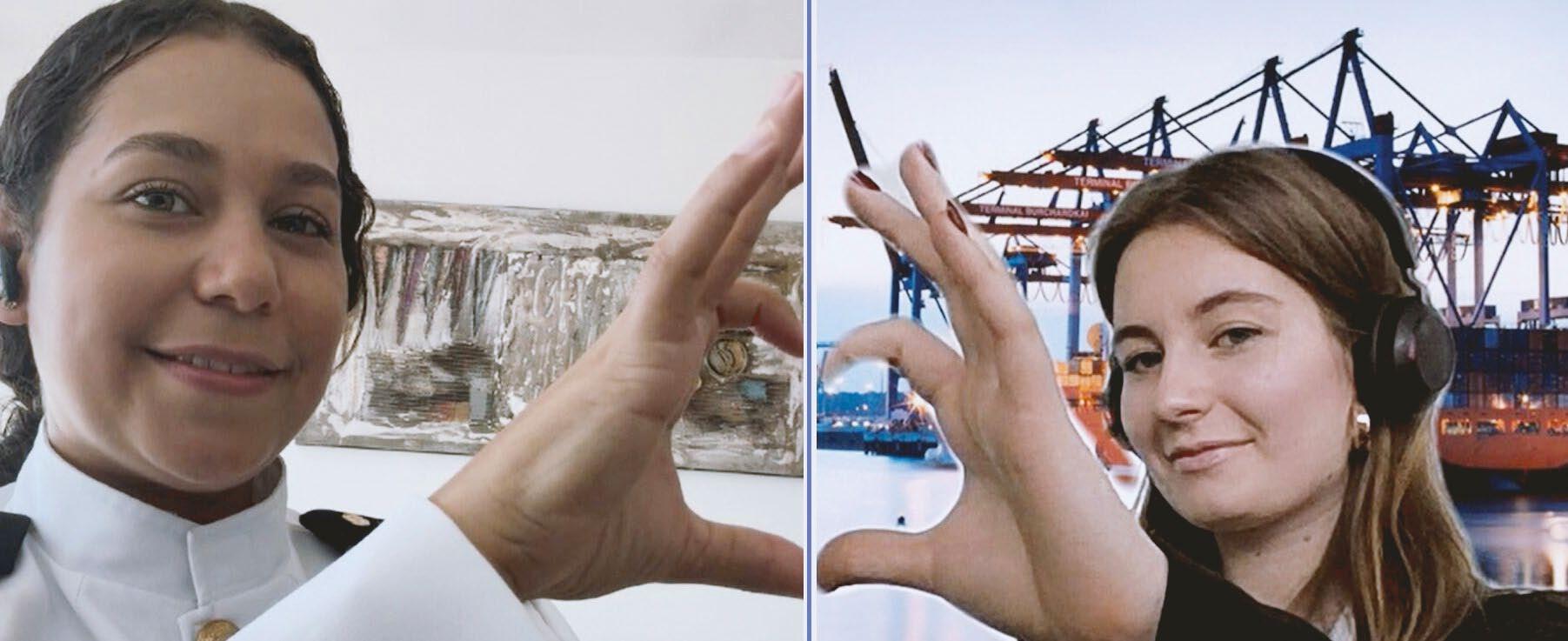
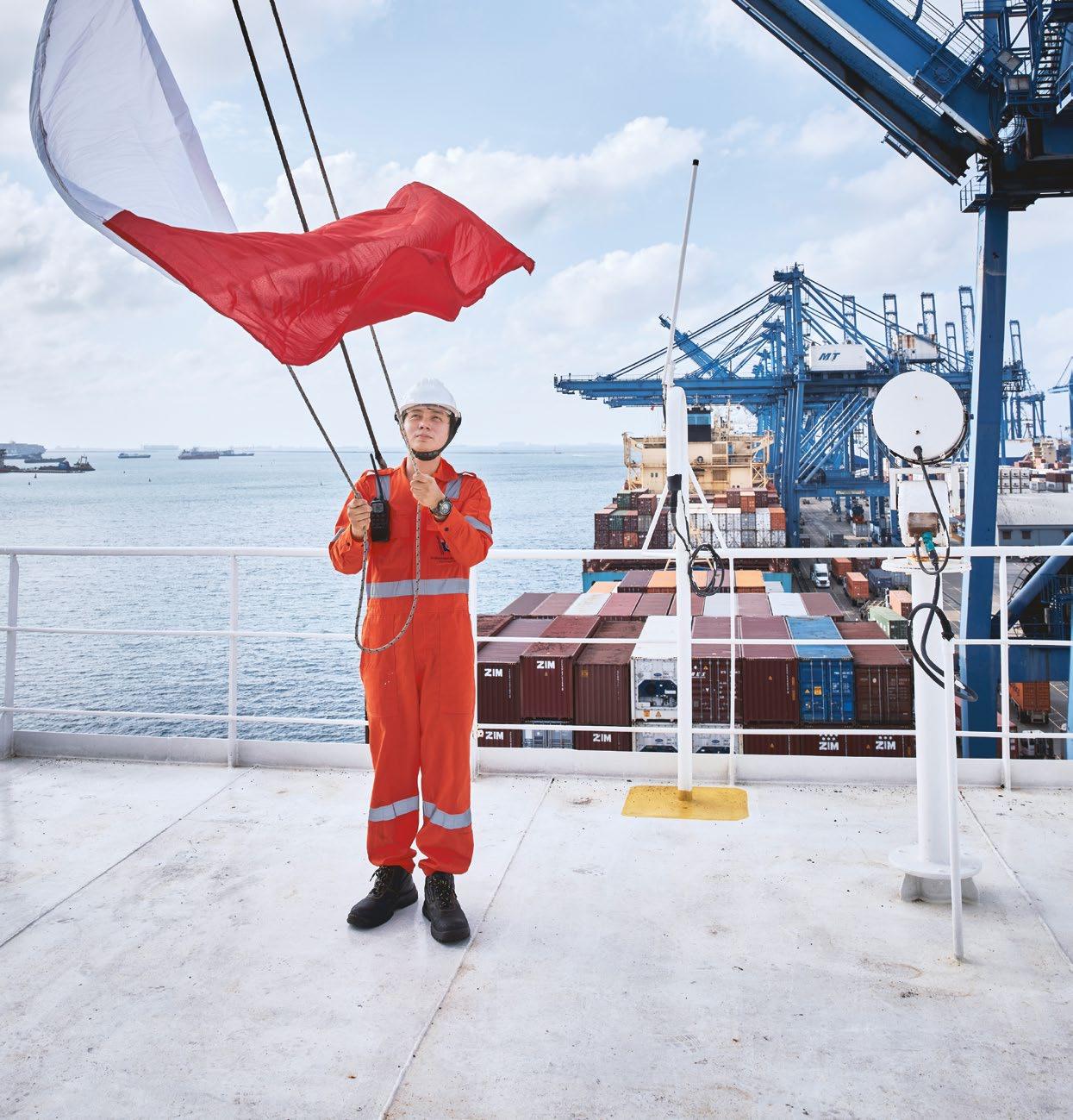

Wilhelmsen Ahrenkiel Ship Management
GmbH & Co. KG
Palmaille 67
22767 Hamburg
Germany
Phone: +49 (40) 7432906-00
E-Mail: contact@wilhelmsen-ahrenkiel.com
www.wilhelmsen-ahrenkiel.com
Head of Editorial Team
Mia-Kaarina Feistner
Editorial Team and Authors
Hanneke de Vriend, Kiril Kirilov, Danylo Myachyn, Carle Olivier, Susanne Petkovic, Marc Reinhard, Sophie Simov, Lucian Stavarache, Peggy van Driel-Asterioti, Alexander Brandenburg, Anuroop Chopra, Ido Cohen, Holger Glandien, Lena-Marie Heick, Murad Ismayilov, Mehmet Keles, Liria Klement, Uwe Lange, Harm Mulder, Marcel Moskalik, Laura Paschburg, Eckard Rogg, Enrico Rupp, Oleksandra Tabakar, Capt. Angel Vasilev
Proofreading and Translation
EVS-Translations GmbH
Design and Typesetting
Joana Nascimento Bunk
Photos sources
Christian O. Bruch
Photos of the authors
WASM photo library